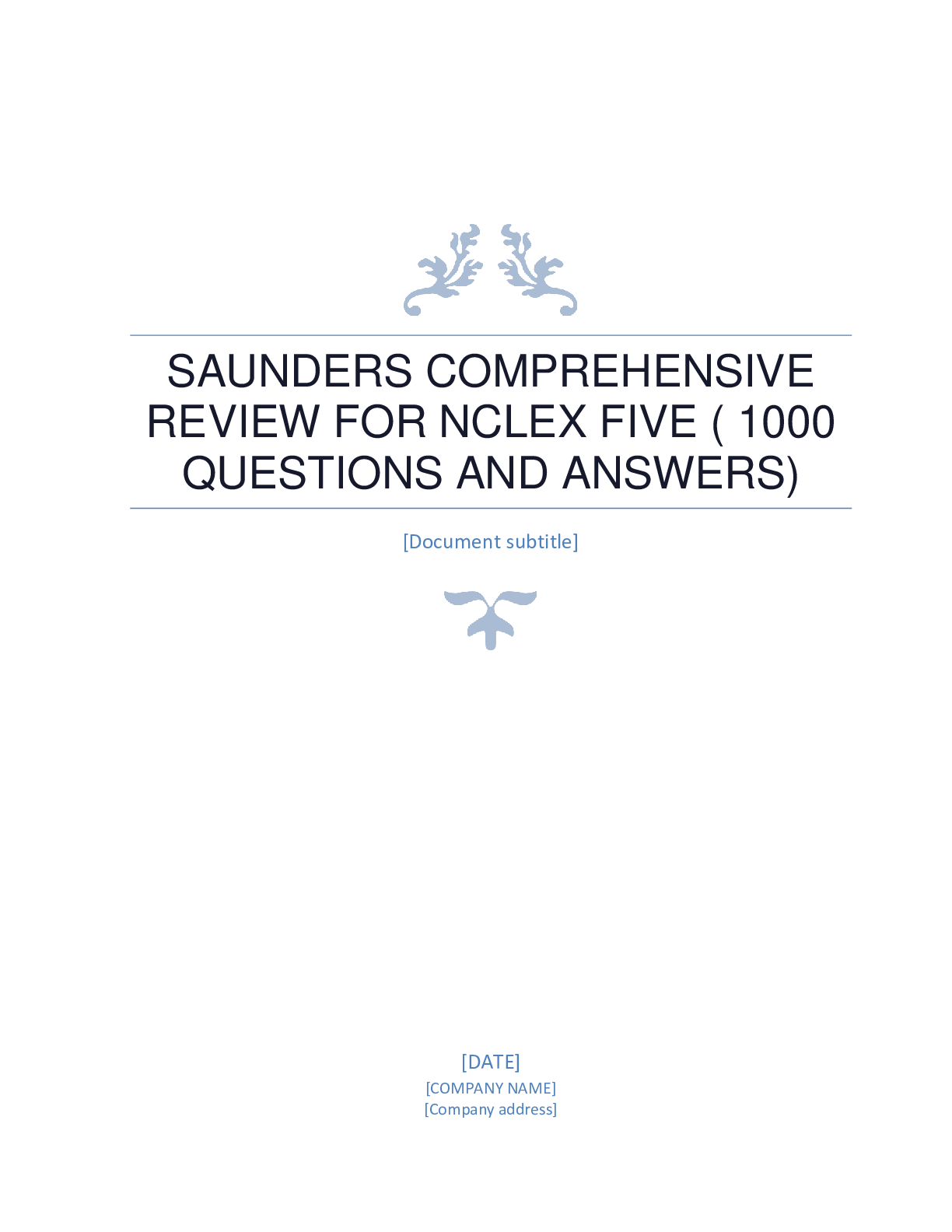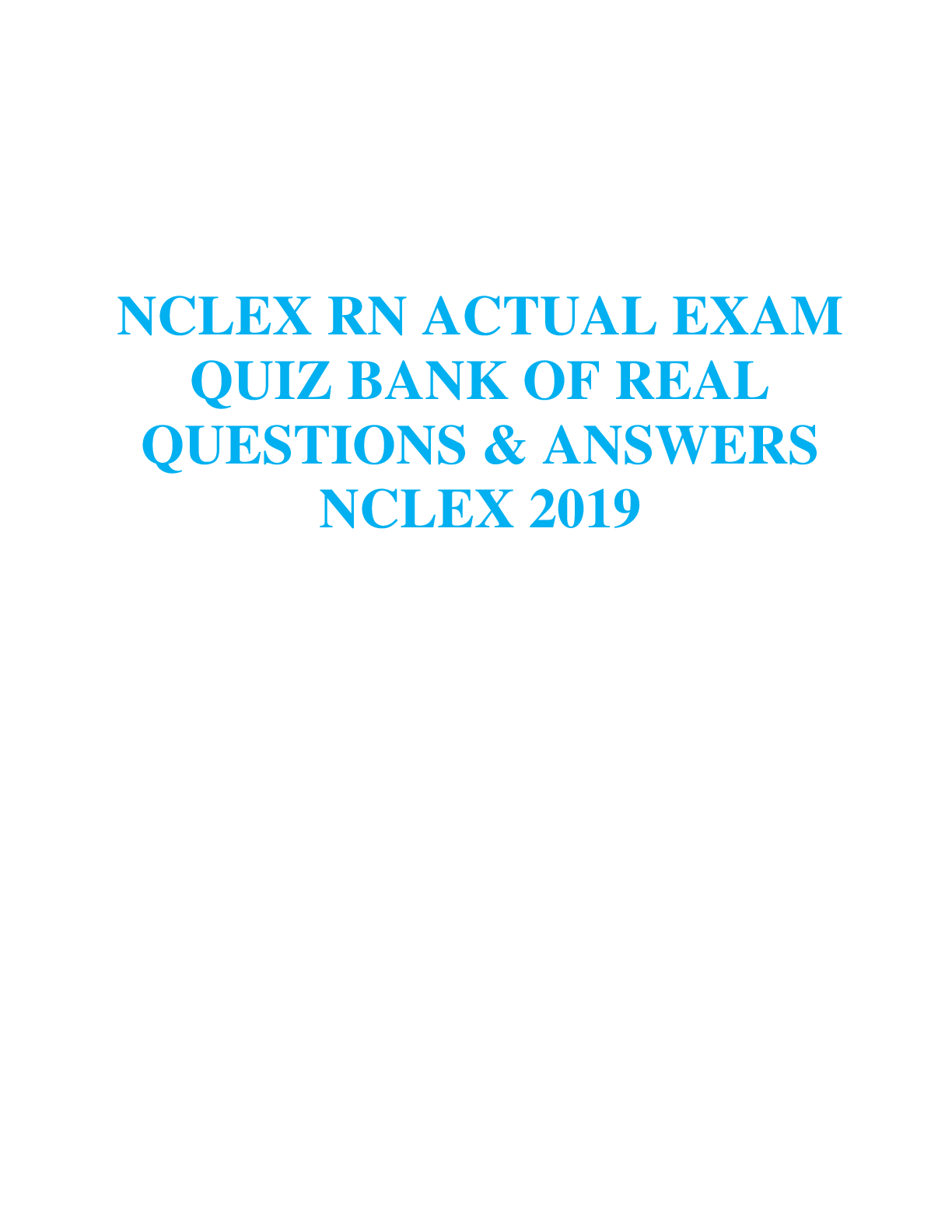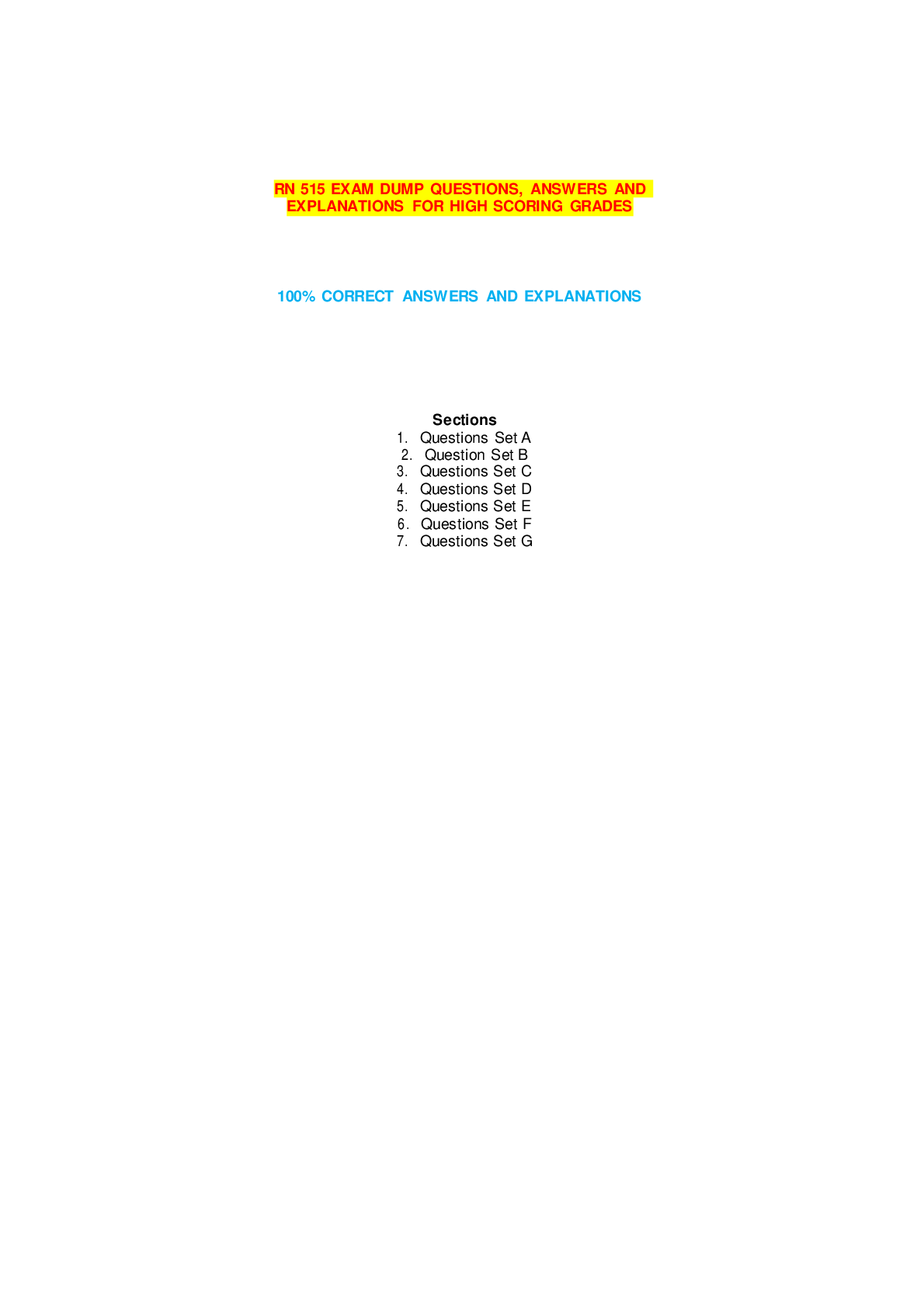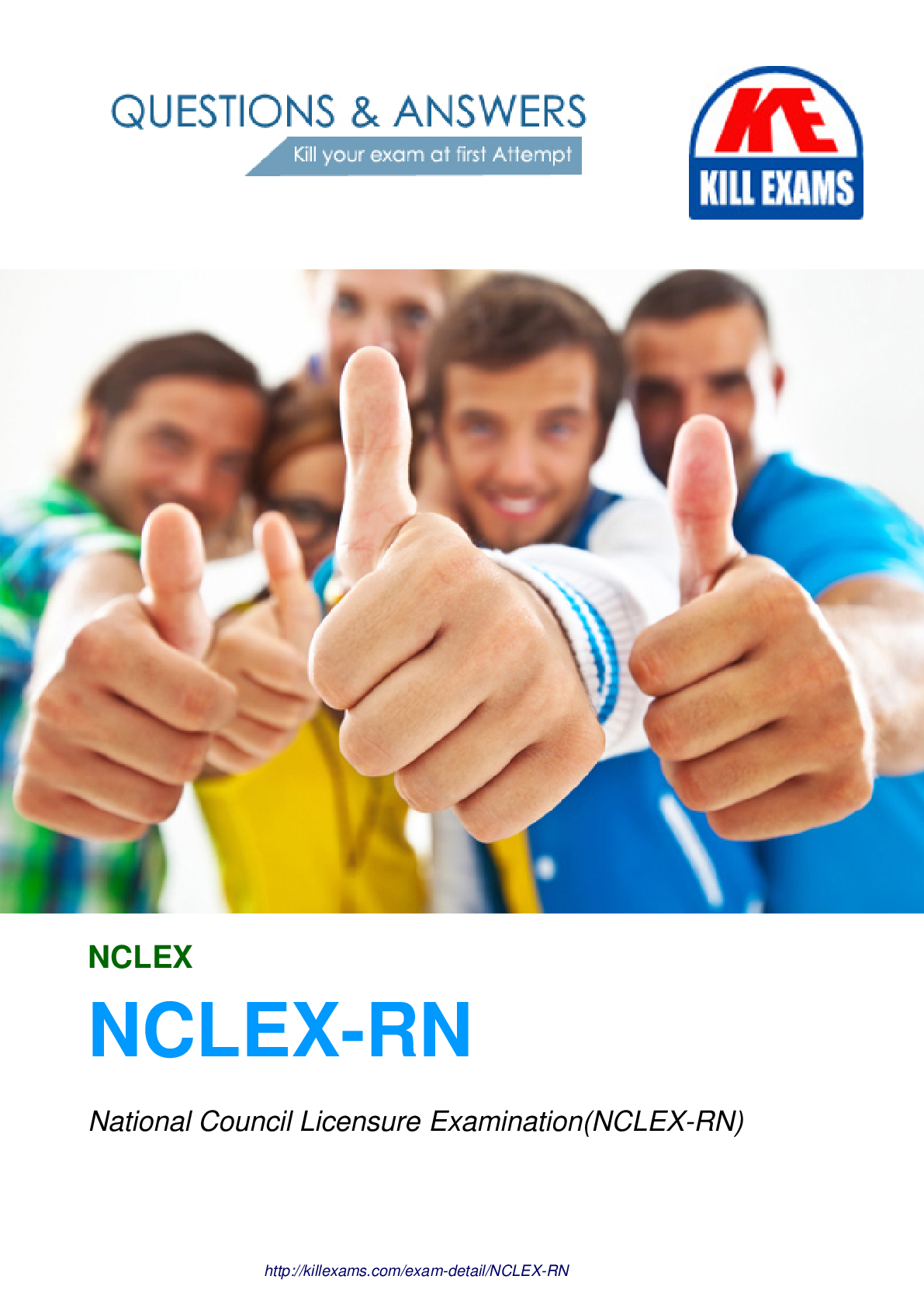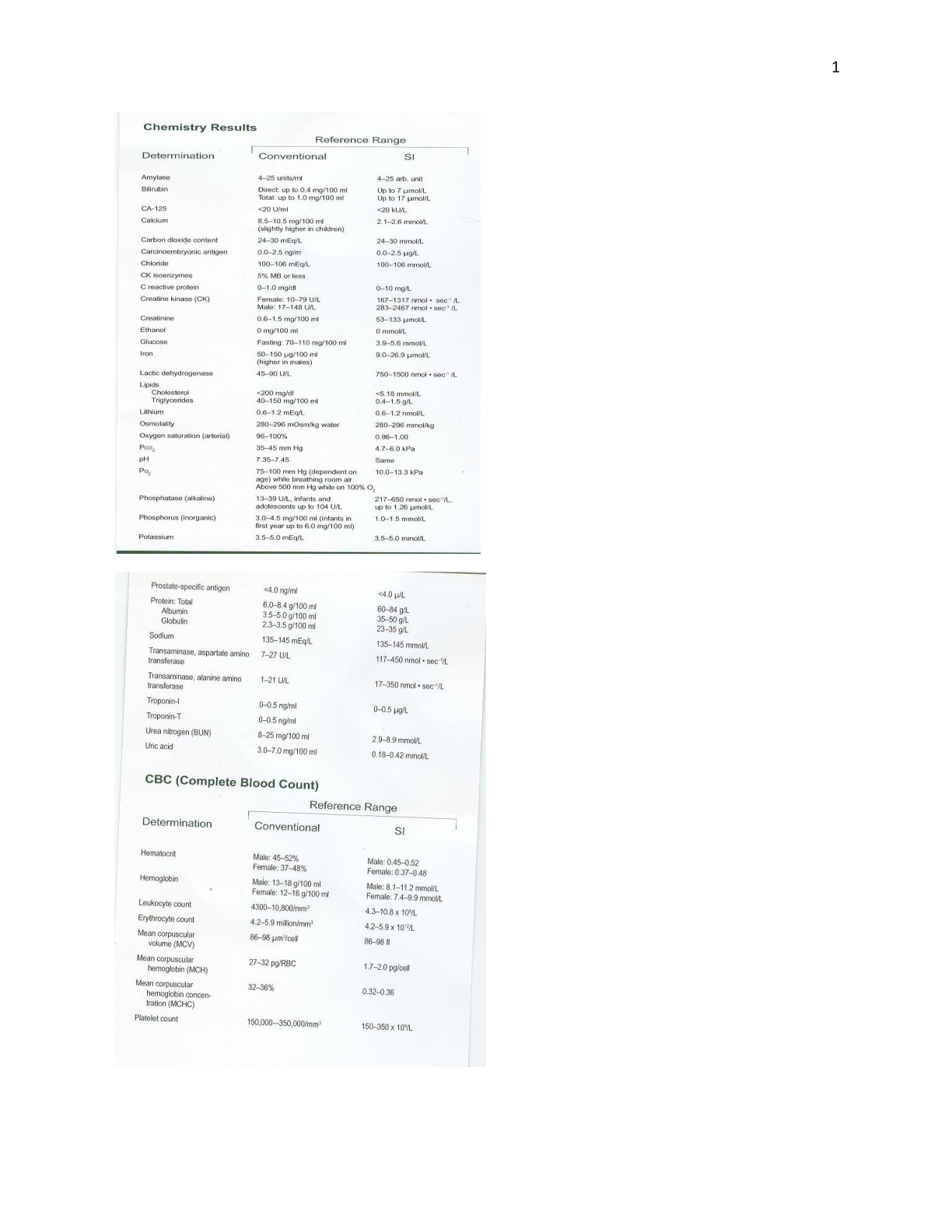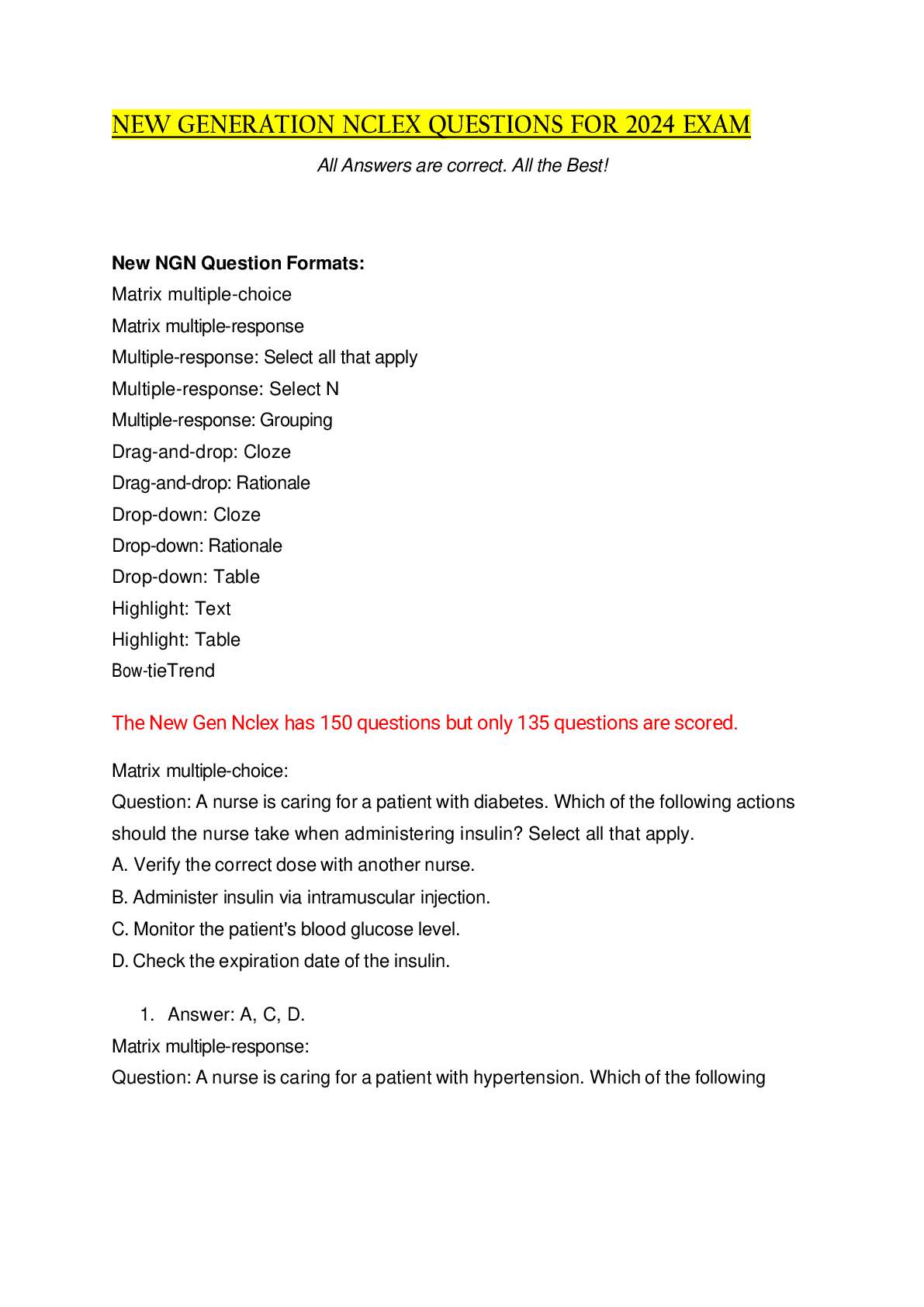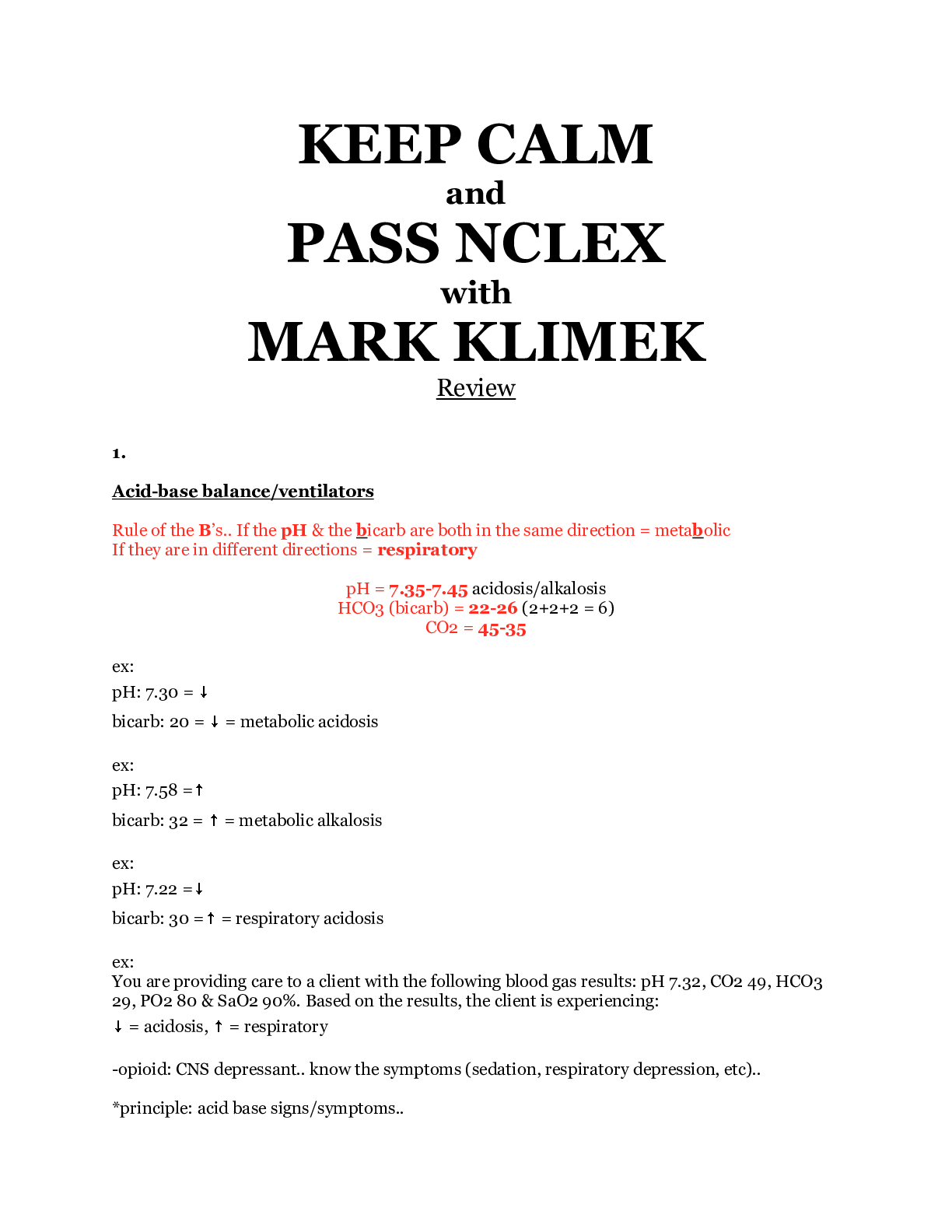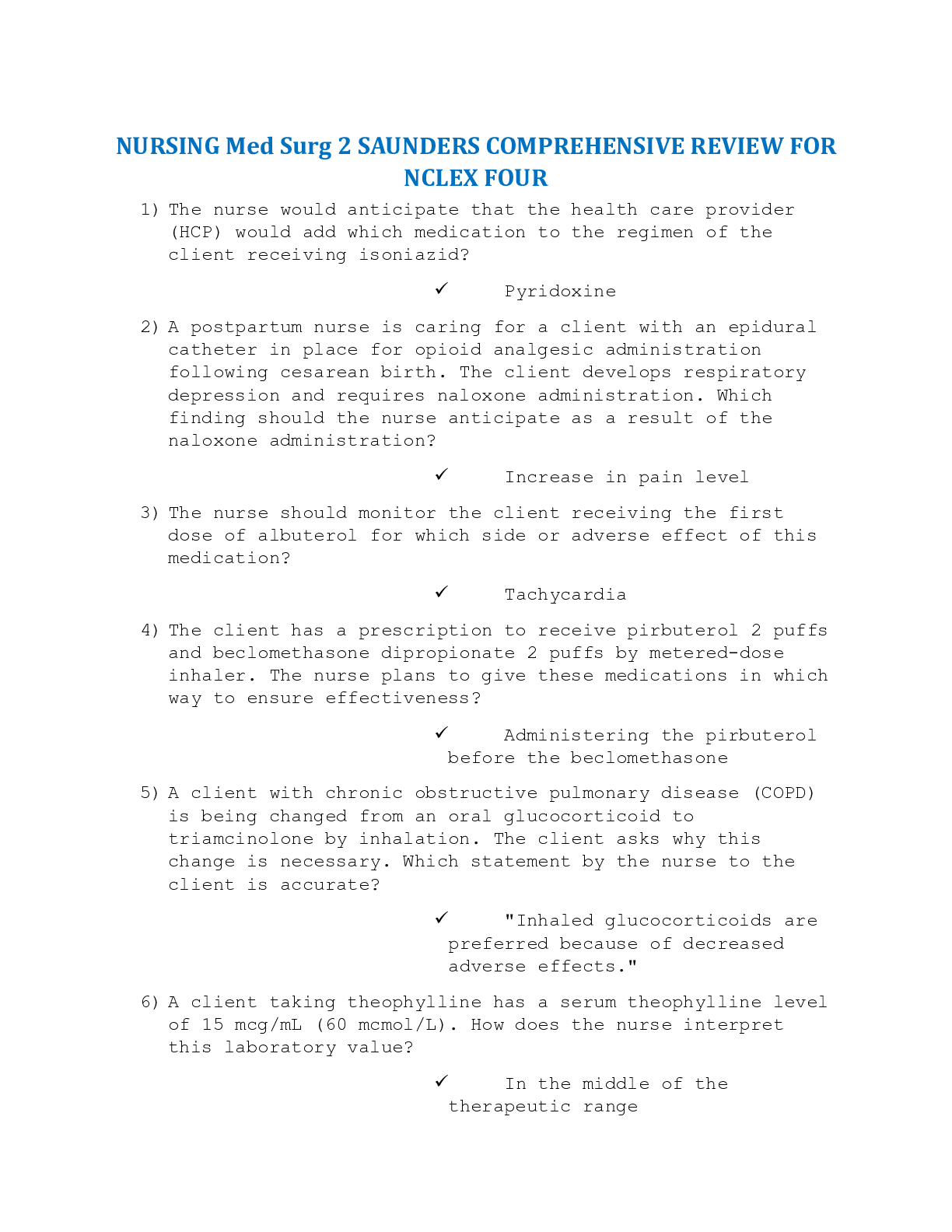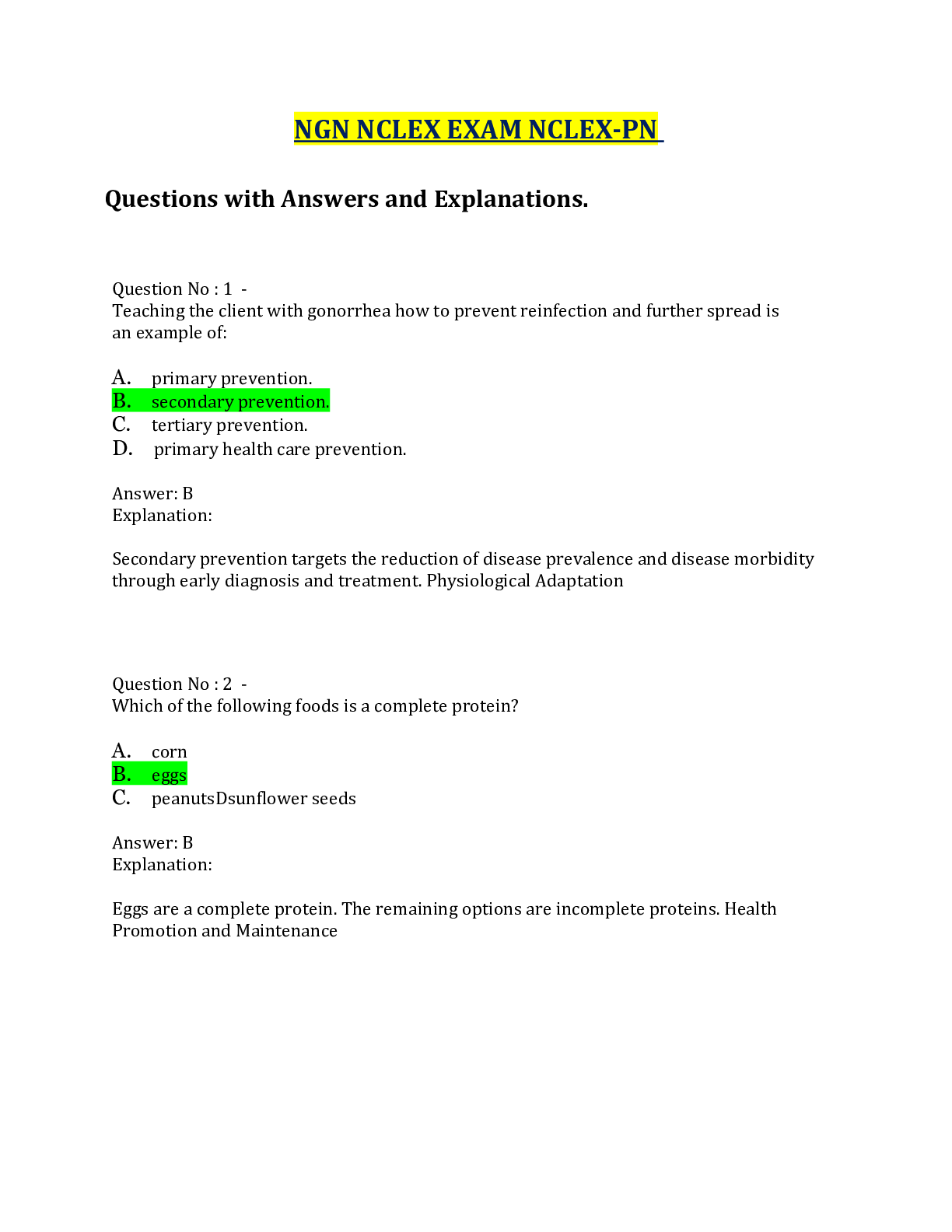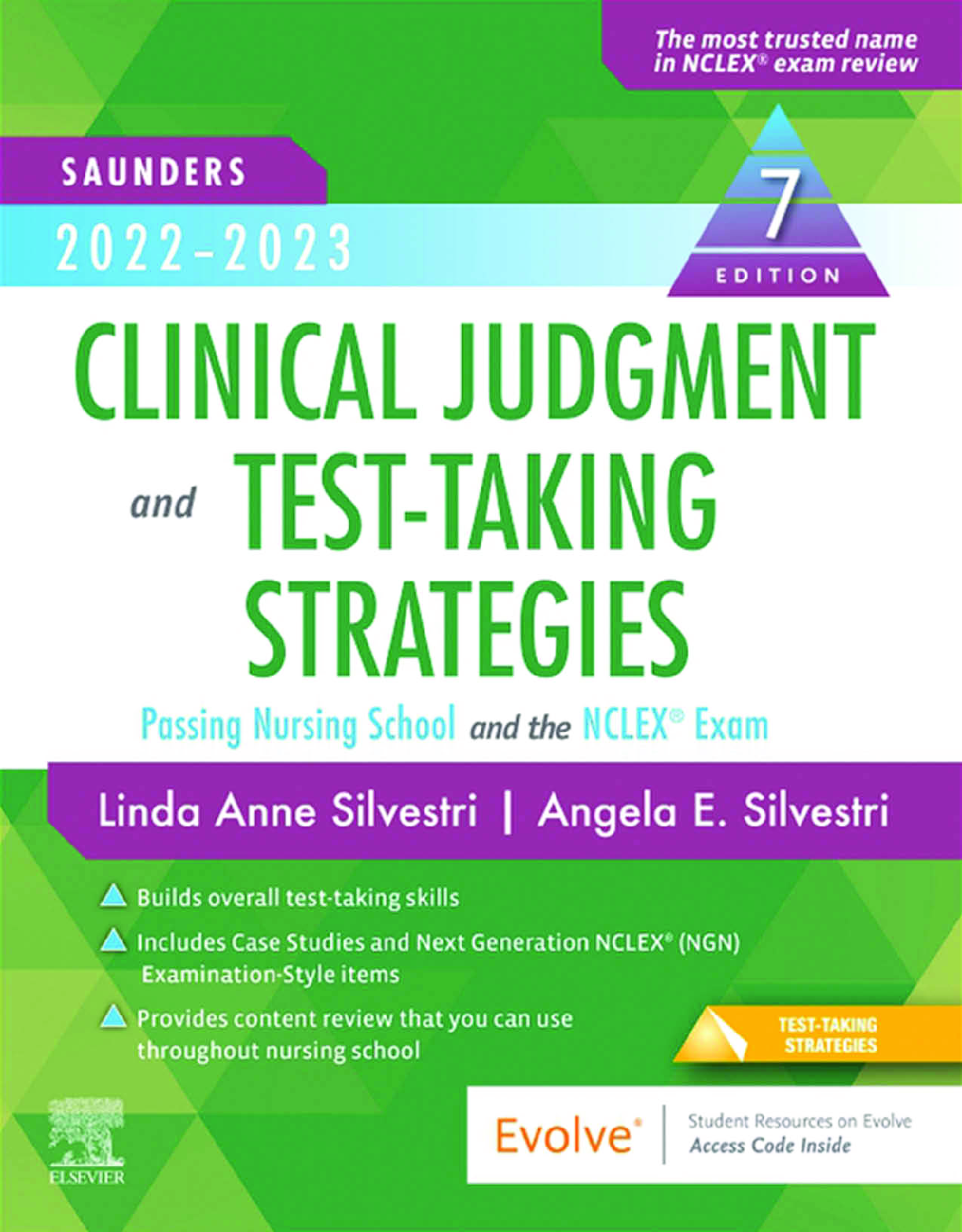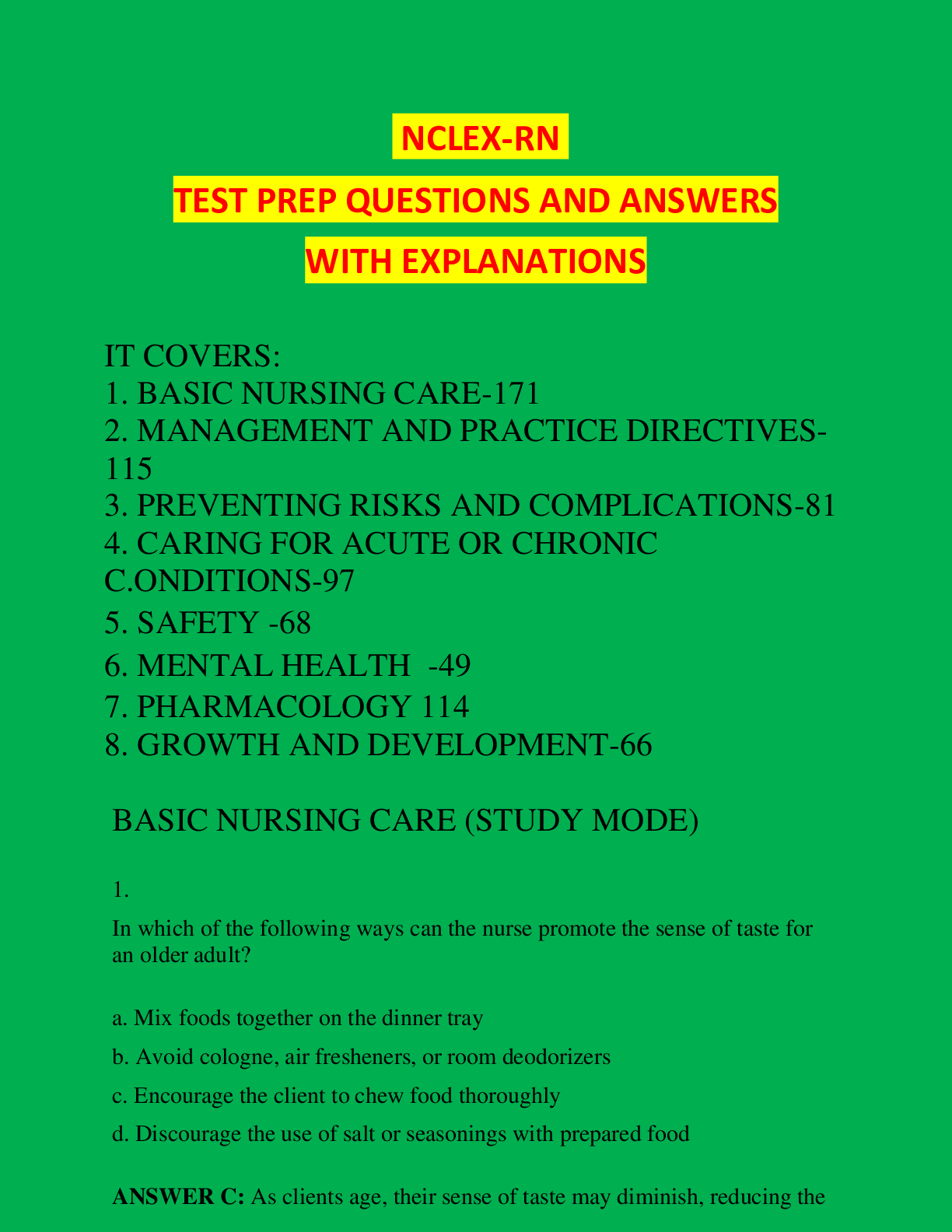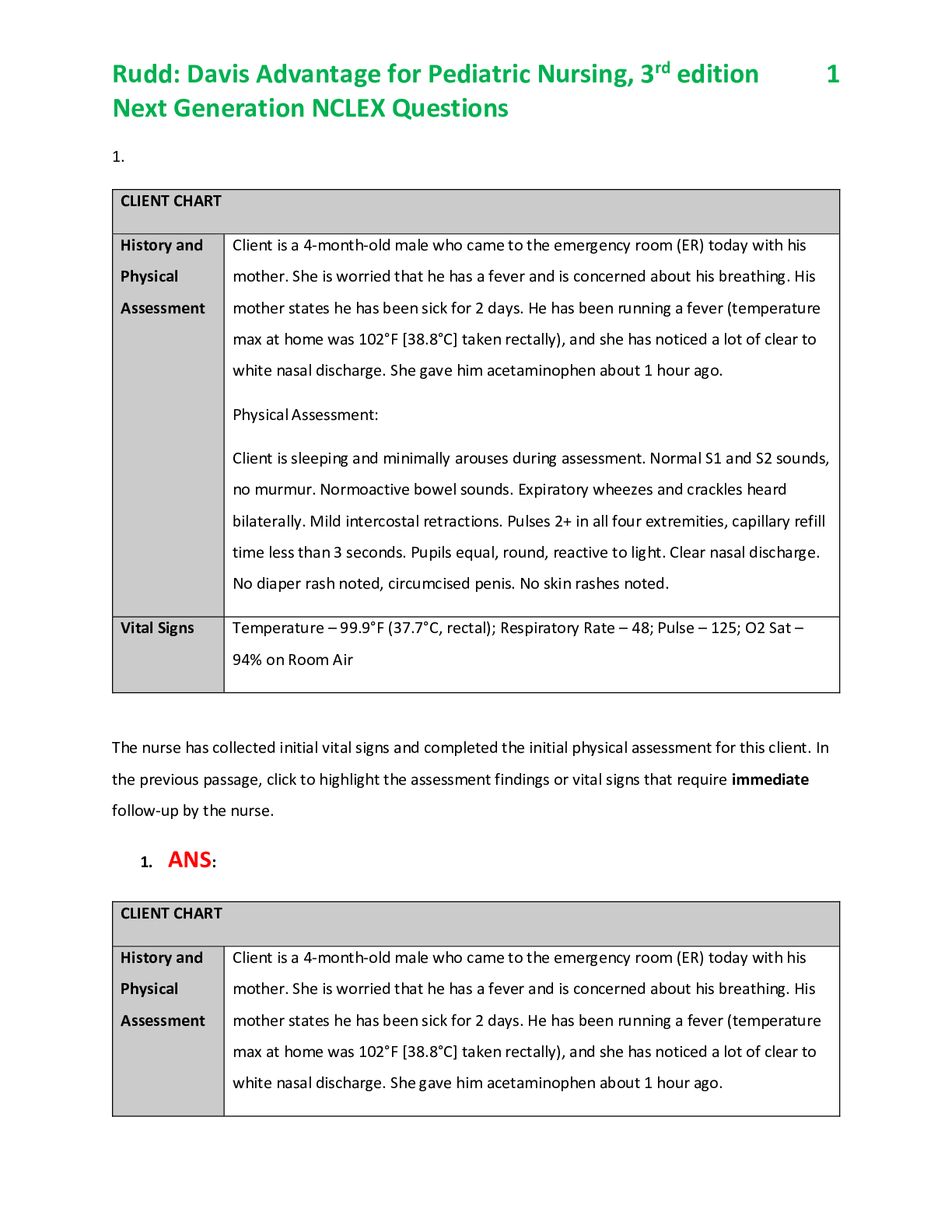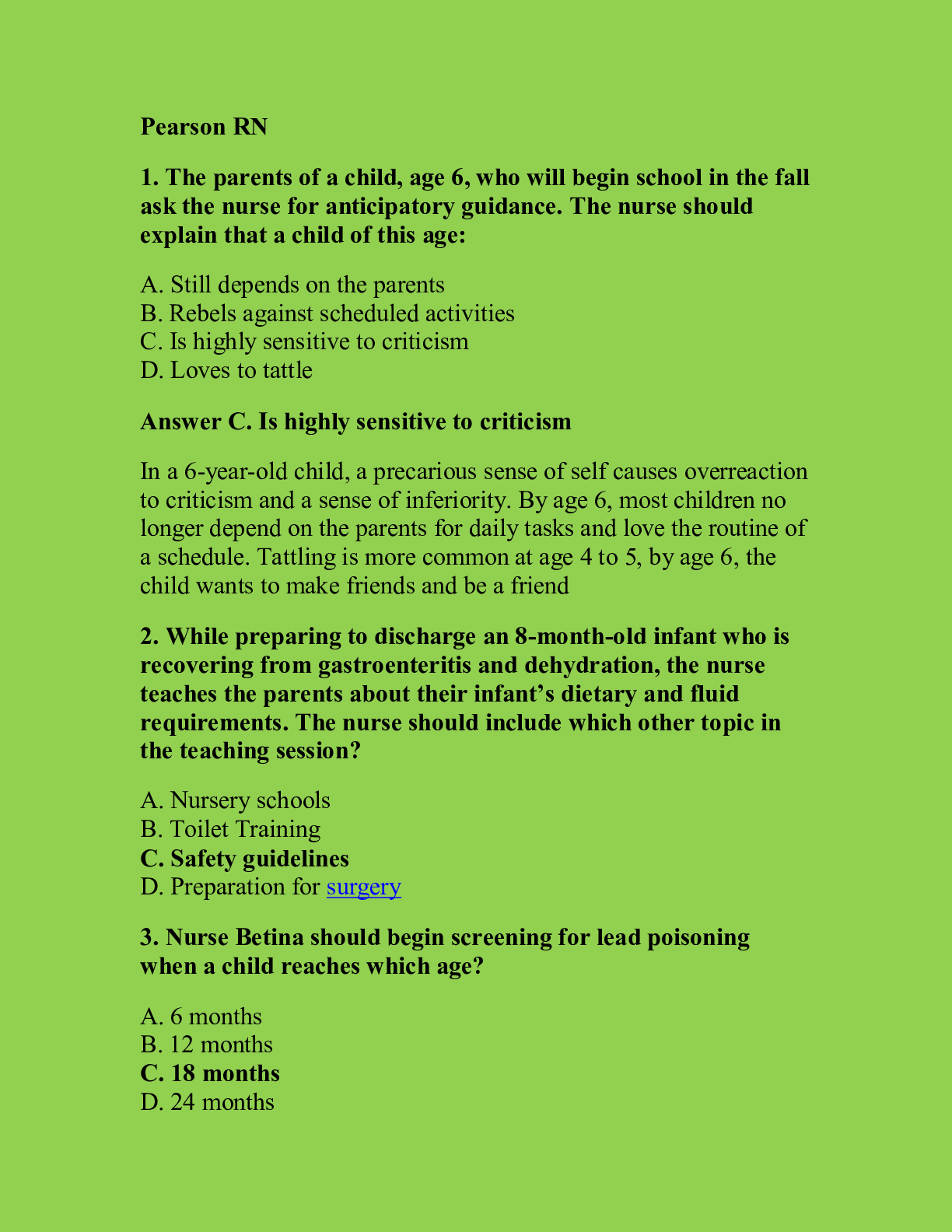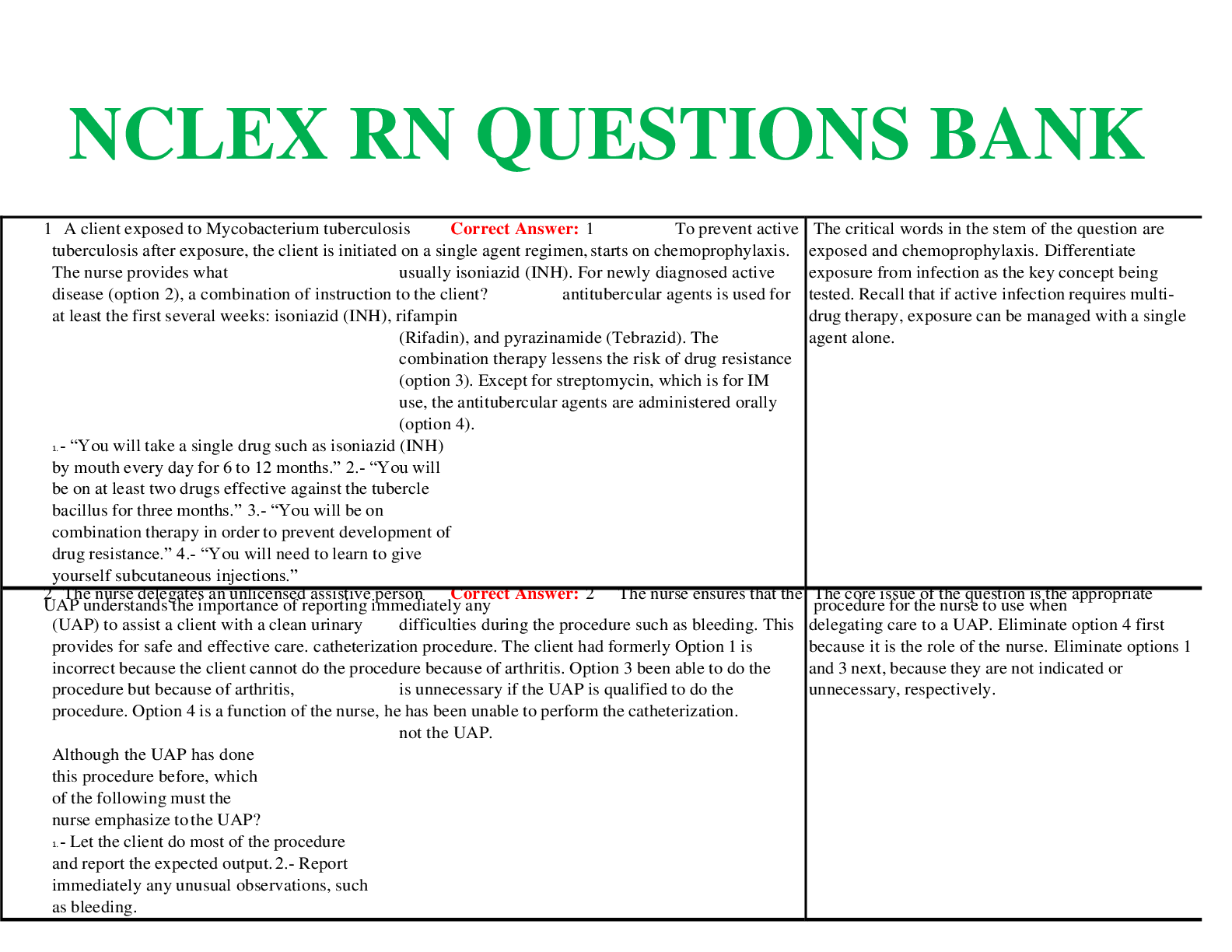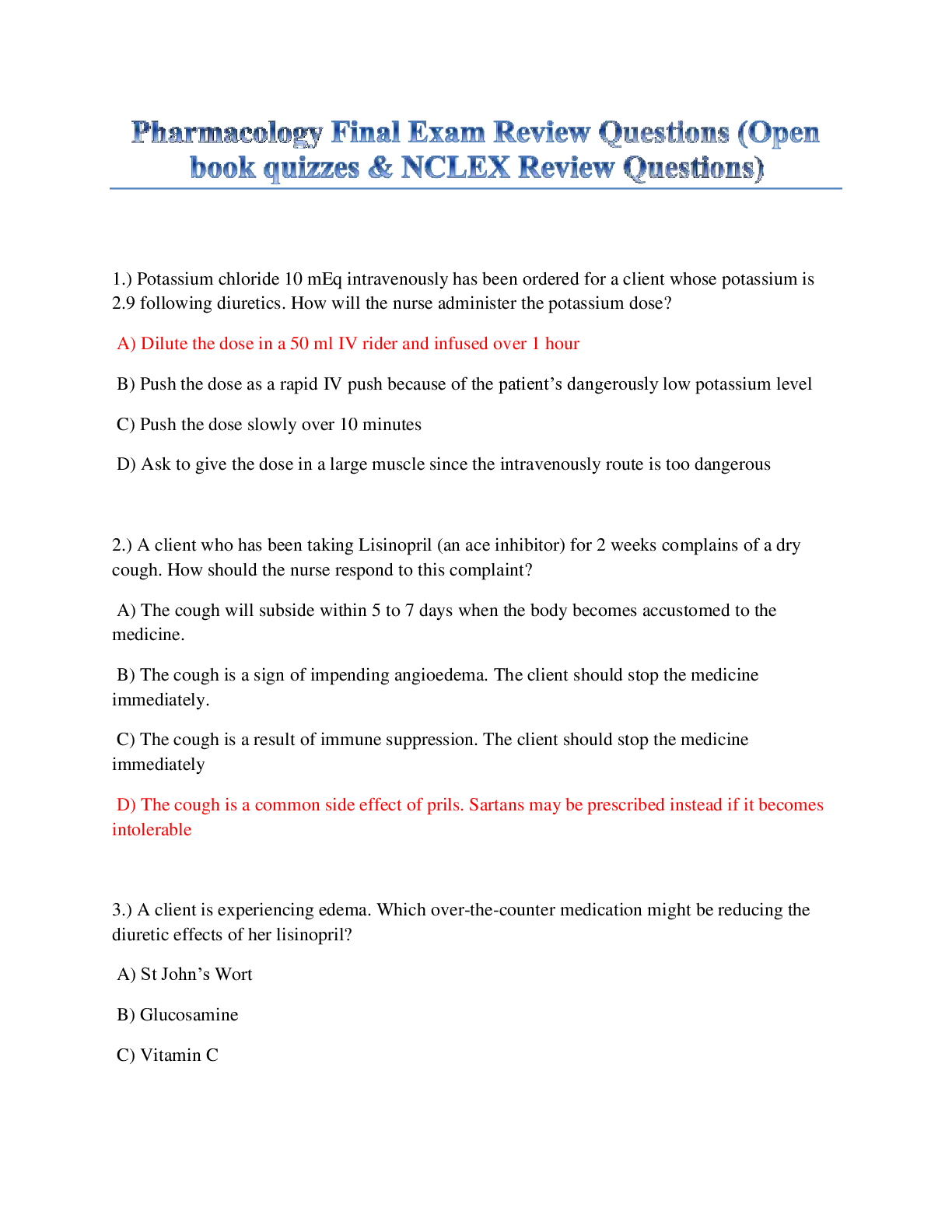*NURSING > NCLEX > NCLEX-RN-NURSING REVIEW (865 QUESTIONS, ANSWERS AND EXPLANATIONS) HIGH SCORING GRADES (301 PAGES) (All)
NCLEX-RN-NURSING REVIEW (865 QUESTIONS, ANSWERS AND EXPLANATIONS) HIGH SCORING GRADES (301 PAGES)
Document Content and Description Below
NO.1 A depressed client is seen at the mental health center for follow-up after an attempted suicide 1 week ago. She has taken phenelzine sulfate (Nardil), a monoamine oxidase (MAO) inhibitor, for 7... straight days. She states that she is not feeling any better. The nurse explains that the drug must accumulate to an effective level before symptoms are totally relieved. Symptom relief is expected to occur within: A. 10 days B. 2-4 weeks C. 2 months D. 3 months Answer: B Explanation: (A) This answer is incorrect. It can take up to 1 month for therapeutic effect of the medication. (B) This answer is correct. Because MAO inhibitors are slow to act, it takes 2-4 weeks before improvement of symptoms is noted. (C) This answer is incorrect. It can take up to 1 month for therapeutic effect of the medication. (D) This answer is incorrect. Therapeutic effects of the medication are noted within 1 month of drug therapy. NO.2 Cystic fibrosis is transmitted as an autosomal recessive trait. This means that: A. Mothers carry the gene and pass it to their sons B. Fathers carry the gene and pass it to their daughters C. Both parents must have the disease for a child to have the disease D. Both parents must be carriers for a child to have the disease Answer: D Explanation: (A) Cystic fibrosis is not an X-linked or sex-linked disease. (B) The only characteristic on the Y chromosome is the trait for hairy ears. (C) Both parents do not need to have the disease but must be carriers. (D) If a trait is recessive, two genes (one from each parent) are necessary to produce an affected child. NO.3 A 24-year-old client presents to the emergency department protesting "I am God." The nurse identifies this as a: A. Delusion B. Illusion 1C. Hallucination D. Conversion Answer: A Explanation: (A) Delusion is a false belief. (B) Illusion is the misrepresentation of a real, external sensory experience. (C) Hallucination is a false sensory perception involving any of the senses. (D) Conversion is the expression of intrapsychic conflict through sensory or motor manifestations. NO.4 In acute episodes of mania, lithium is effective in 1-2 weeks, but it may take up to 4 weeks, or even a few months, to treat symptoms fully. Sometimes an antipsychotic agent is prescribed during the first few days or weeks of an acute episode to manage severe behavioral excitement and acute psychotic symptoms. In addition to the lithium, which one of the following medications might the physician prescribe? A. Diazepam (Valium) B. Haloperidol (Haldol) C. Sertraline (Zoloft) D. Alprazolam (Xanax) Answer: B Explanation: (A) Diazepam is an antianxiety medication and is not designed to reduce psychotic symptoms. (B) Haloperidol is an antipsychotic medication and may be used until the lithium takes effect. (C) Sertraline is an antidepressant and is used primarily to reduce symptoms of depression. (D) Alprazolam is an antianxiety medication and is not designed to reduce psychotic symptoms. NO.5 A violent client remains in restraints for several hours. Which of the following interventions is most appropriate while he is in restraints? A. Give fluids if the client requests them. B. Assess skin integrity and circulation of extremities before applying restraints and as they areremoved. C. Measure vital signs at least every 4 hours. D. Release restraints every 2 hours for client to exercise. Answer: D Explanation: (A) Fluids (nourishment) should be offered at regular intervals whether the client requests (or refuses) them or not. (B) Skin integrity and circulation of the extremities should be checked regularly while the client is restrained, not only before restraints are applied and after they are removed. (C) Vital signs should be checked at least every 2 hours. If the client remains agitated in restraints, vital signs should be monitored even more closely, perhaps every 1-2 hours. (D) Restraints should be released every 2 hours for exercise, one extremity at a time, to maintain muscle tone, skin and joint integrity, and circulation. NO.6 The pediatrician has diagnosed tinea capitis in an 8- year-old girl and has placed her on oral griseofulvin. The nurse should emphasize which of these instructions to the mother and/or child? A. Administer oral griseofulvin on an empty stomach for best results. B. Discontinue drug therapy if food tastes funny. C. May discontinue medication when the child experiences symptomatic relief. D. Observe for headaches, dizziness, and anorexia. 2Answer: D Explanation: (A) Giving the drug with or after meals may allay gastrointestinal discomfort. Giving the drug with a fatty meal (ice cream or milk) increases absorption rate. (B) Griseofulvin may alter taste sensations and thereby decrease the appetite. Monitoring of food intake is important, and inadequate nutrient intake should be reported to the physician. (C) The child may experience symptomatic relief after 4896 hours of therapy. It is important to stress continuing the drug therapy to prevent relapse (usually about 6 weeks). (D) The incidence of side effects is low; however, headaches are common. Nausea, vomiting, diarrhea, and anorexia may occur. Dizziness, although uncommon, should be reported to the physician. NO.7 A client with cirrhosis of the liver becomes comatose and is started on neomycin 300 mg q6h via nasogastric tube. The rationale for this therapy is to: A. Prevent systemic infection B. Promote diuresis C. Decrease ammonia formation D. Acidify the small bowel Answer: C Explanation: (A) Neomycin is an antibiotic, but this is not the Rationale for administering it to a client in hepatic coma. (B) Diuretics and salt-free albumin are used to promote diuresis in clients with cirrhosis of the liver. (C) Neomycin destroys the bacteria in the intestines. It is the bacteria in the bowel that break down protein into ammonia. (D) Lactulose is administered to create an acid environment in the bowel. Ammonia leaves the blood and migrates to this acidic environment where it is trapped and excreted. NO.8 A 5-year-old has just had a tonsillectomy and adenoidectomy. Which of these nursing measures should be included in the postoperative care? A. Encourage the child to cough up blood if present. B. Give warm clear liquids when fully alert. C. Have child gargle and do toothbrushing to remove old blood. D. Observe for evidence of bleeding. Answer: D Explanation: (A) The nurse should discourage the child from coughing, clearing the throat, or putting objects in his mouth. These may induce bleeding. (B) Cool, clear liquids may be given when child is fully alert. Warm liquids may dislodge a blood clot. The nurse should avoid red- or brown-colored liquids to distinguish fresh or old blood from ingested liquid should the child vomit. (C) Gargles and vigorous toothbrushing could initiate bleeding. (D) Postoperative hemorrhage, though unusual, may occur. The nurse should observe for bleeding by looking directly into the throat and for vomiting of bright red blood, continuous swallowing, and changes in vital signs. NO.9 An 80-year-old male client with a history of arteriosclerosis is experiencing severe pain in his left leg that started approximately 20 minutes ago. When performing the admission assessment, the nurse would expect to observe which of the following: 3A. Both lower extremities warm to touch with 2_pedal pulses B. Both lower extremities cyanotic when placed in a dependent position C. Decreased or absent pedal pulse in the left leg D. The left leg warmer to touch than the right leg Answer: C Explanation: (A) This statement describes a normal assessment finding of the lower extremities. (B) This assessment finding reflects problems caused by venous insufficiency. (C) Decreased or absentpedal pulses reflect a problem caused by arterial insufficiency. (D) The leg that is experiencing arterial insufficiency would be cool to touch due to the decreased circulation. NO.10 A 16-month-old infant is being prepared for tetralogy of Fallot repair. In the nursing assessment, which lab value should elicit further assessment and requires notification of physician? A. pH 7.39 B. White blood cell (WBC) count 10,000 WBCs/mm3 C. Hematocrit 60% D. Bleeding time of 4 minutes Answer: C Explanation: (A) Normal pH of arterial blood gases for an infant is 7.35-7.45. (B) Normal white blood cell count in an infant is 6,000-17,500 WBCs/mm3. (C) Normal hematocrit in infant is 28%-42%. A 60% hematocrit may indicate polycythemia, a common complication of cyanotic heart disease. (D) Normal bleeding time is 2-7 minutes. NO.11 A male client is experiencing extreme distress. He begins to pace up and down the corridor. What nursing intervention is appropriate when communicating with the pacing client? A. Ask him to sit down. Speak slowly and use short, simple sentences. B. Help him to recognize his anxiety. C. Walk with him as he paces. D. Increase the level of his supervision. Answer: C Explanation: (A) The nurse should not ask him to sit down. Pacing is the activity he has chosen to deal with his anxiety. The nurse dealing with this client should speak slowly and with short, simplesentences. (B) The client may already recognize the anxiety and is attempting to deal with it. (C) Walk with the client as he paces. This gives support while he uses anxiety-generated energy. (D) Increasing the level of supervision may be appropriate after he stops pacing. It would minimize self-injury and/or loss of control. NO.12 Prior to an amniocentesis, a fetal ultrasound is done in order to: A. Evaluate fetal lung maturity B. Evaluate the amount of amniotic fluid C. Locate the position of the placenta and fetus D. Ensure that the fetus is mature enough to perform the amniocentesis 4Answer: C Explanation: (A) Amniocentesis can be performed to assess for lung maturity. Fetal ultrasound can be used for gestational dating, although it does not separately determine lung maturity. (B) Ultrasound can evaluate amniotic fluid volume, which may be used to determine congenital anomalies. (C) Amniocentesis involves removal of amniotic fluid for evaluation. The needle, inserted through the abdomen, is guided by ultrasound to avoid needle injuries, and the test evaluates the position of the placenta and the fetus. (D) Amniocentesis can be performed as early as the 15th-17th week of pregnancy. NO.13 A 25-year-old client believes she may be pregnant with her first child. She schedules an obstetric examination with the nurse practitioner to determine the status of her possible pregnancy. Her last menstrual period began May 20, and her estimated date of confinement using Nagele's rule is: A. March 27 B. February 1 C. February 27 D. January 3 Answer: C Explanation: (A)March 27 is a miscalculation. (B) February 1 is a miscalculation. (C) February 27 is the correct answer. To calculate the estimated date of confinement using Nagele's rule, subtract 3 months from the date that the last menstrual cycle began and then add 7 days to the result. (D) January 3 is a miscalculation. NO.14 A client is now pregnant for the second time. Her first child weighed 4536 g at delivery. The client's glucose tolerance test shows elevated blood sugar levels. Because she only shows signs of diabetes when she is pregnant, she is classified as having: A. Insulin-dependent diabetes B. Type II diabetes mellitus C. Type I diabetes mellitus D. Gestational diabetes mellitus Answer: D Explanation: (A) Insulin-dependent diabetes mellitus, also known as type I diabetes, usually appears before the age of 30 years with an abrupt onset of symptoms requiring insulin for management. It is not related to onset during pregnancy. (B) Non-insulin-dependent diabetes (type II diabetes) usually appears in older adults. It has a slow onset and progression of symptoms. (C) This type of diabetes is the same as insulin-dependent diabetes. (D) Gestational diabetes mellitus has its onset of symptoms during pregnancy and usually disappears after delivery. These symptoms are usually mild and not life threatening, although they are associated with increased fetal morbidity and other fetal complications. NO.15 A 44-year-old female client is receiving external radiation to her scapula for metastasis of breast cancer. 5Teaching related to skin care for the client would include which of the following? A. Teach her to completely clean the skin to remove all ointments and markings after each treatment . B. Teach her to cover broken skin in the treated area with a medicated ointment. C. Encourage her to wear a tight-fitting vest to support her scapula. D. Encourage her to avoid direct sunlight on the area being treated. Answer: D Explanation: (A) The skin in a treatment area should be rinsed with water and patted dry. Markings should be left intact, and the skin should not be scrubbed. (B) Clients should avoid putting any creams or lotions on the treated area. This could interfere with treatment. (C) Radiation therapy clients should wear loosefitting clothes and avoid tight, irritating fabrics. (D) The area of skin being treated is sensitive to sunlight, and the client should take care to prevent sun damage by avoiding direct sunlight and covering the area when she is in the sun. NO.16 The nurse is assisting a 4th-day postoperative cholecystectomy client in planning her meals for tomorrow's menu. Which vitamin is the most essential in promoting tissue healing? A. Vitamin C B. Vitamin B1 C. Vitamin D D. Vitamin AAnswer: A Explanation: (A) Vitamin C (ascorbic acid) is essential in promoting wound healing and collagen formation. (B) Vitamin B1 (thiamine) maintains normal gastrointestinal (GI) functioning, oxidizes carbohydrates, and is essential for normal functioning of nervous tissue. (C) Vitamin D regulates absorption of calcium and phosphorus from the GI tract and helps prevent rickets. (D) Vitamin A is necessary for the formation and maintenance of skin and mucous membranes. It is also essential for normal growth and development of bones and teeth. NO.17 A 10-year-old client with a pin in the right femur is immobilized in traction. He is exhibiting behavioral changes including restlessness, difficulty with problem solving, inability to concentrate on activities, and monotony. Which of the following nursing implementations would be most effective in helping him cope with immobility? A. Providing him with books, challenging puzzles, and games as diversionary activities B. Allowing him to do as much for himself as he is able, including learning to do pin-site care undersupervision C. Having a volunteer come in to sit with the client and to read him stories D. Stimulating rest and relaxation by gentle rubbing with lotion and changing the client's positionfrequently Answer: B Explanation: (A) These activities could be frustrating for the client if he is having difficulty with problem solving and concentration. (B) Selfcare is usually well received by the child, and it is one of the most useful interventions to help the child cope with immobility. (C) This may be helpful to the client if he has no visitors, but it does little to help him develop coping skills. (D) This will helpto prevent skin irritation or breakdown related to immobility but will not help to prevent behavioral changes related to immobility. 6NO.18 In client teaching, the nurse should emphasize that fetal damage occurs more frequently with ingestion of drugs during: A. First trimester B. Second trimester C. Third trimester D. Every trimester Answer: A Explanation: (A) Organogenesis occurs in the first trimester. Fetus is most susceptible to malformation during this period. (B) Organogenesis has occurred by the second trimester. (C) Fetal development is complete by this time. (D) The dangerous period for fetal damage is the first trimester, not the entire pregnancy. NO.19 On admission, the client has signs and symptoms of pulmonary edema. The nurse places the client in the most appropriate position for a client in pulmonary edema, which is: A. High Fowler B. Lying on the left side C. Sitting in a chair D. Supine with feet elevated Answer: A Explanation: (A) High Fowler position decreases venous return to the heart and permits greater lung expansion so that oxygenation is maximized. (B) Lying on the left side may improve perfusion to the left lung but does not promote lung expansion. (C) Sitting in a chair will decrease venous return and promote maximal lung expansion. However, clients with pulmonary edema can deteriorate quickly and require intubation and mechanical ventilation. If a client is sitting in achair when this deterioration happens, it will be difficult to intervene quickly. (D) The supine with feet elevated position increases venous return and will worsen pulmonary edema. NO.20 A client has returned to the unit from the recovery room after having a thyroidectomy. The nurse knows that a major complication after a thyroidectomy is: A. Respiratory obstruction B. Hypercalcemia C. Fistula formation D. Myxedema Answer: A Explanation: (A) Respiratory obstruction due to edema of the glottis, bilateral laryngeal nerve damage, or tracheal compression from hemorrhage is a major complication after a thyroidectomy. (B) Hypocalcemia accompanied by tetany from accidental removal of one or more parathyroid glands is a major complication, not hypercalcemia. (C) Fistula formation is not a major complication associated with a thyroidectomy. It is a major complication with a laryngectomy.(D) Myxedema is 7hypothyroidism that occurs in adults and is not a complication of a thyroidectomy. A thyroidectomy client tends to develop thyroid storm, which is excess production of thyroid hormone. NO.21 The nurse should facilitate bonding during the postpartum period. What should the nurse expect to observe in the taking-hold phase? A. Mother is concerned about her recovery. B. Mother calls infant by name. C. Mother lightly touches infant. D. Mother is concerned about her weight gain. Answer: B Explanation: (A) This observation can be made during the taking-in phase when the mother's needs are more important. (B) This observation can be made during the taking-hold phase when the mother is actively involved with herself and the infant. (C, D) This observation can be made during the taking-in phase. NO.22 A female client has just died. Her family is requesting that all nursing staff leave the room. The family's religious leader has arrived and is ready to conduct a ceremony for the deceased in the room, requesting that only family members be present. The nurse assigned to the client should perform the appropriate nursing action, which might include: A. Inform the family that it is the hospital's policy not to conduct religious ceremonies in client rooms . B. Refuse to leave the room because the client's body is entrusted in the nurse's care until it can bebrought to the morgue. C. Tell the family that they may conduct their ceremony in the client's room; however, the nursemust attend. D. Respect the client's family's wishes. Answer: D Explanation: (A) It is rare that a hospital has a specific policy addressing this particular issue. If the statement is true, the nurse should show evidence of the policy to the family and suggest alternatives, such as the hospital chapel. (B) Refusal to leave the room demonstrates a lack of understanding related to the family's need to grieve in their own manner. (C) The nurse should leave the room and allow the family privacy in their grief. (D) The family's wish to conduct a religious ceremony in the client's room is part of the grief process. The request is based on specific cultural and religious differences dictating social customs. NO.23 A woman diagnosed with multiple sclerosis is disturbed with diplopia. The nurse will teach her to: A. Limit activities which require focusing (close vision) B. Take more frequent naps C. Use artificial tears D. Wear a patch over one eye Answer: D Explanation: (A) 8Limiting activities requiring close vision will not alleviate the discomfort of double vision. (B) Frequent naps may be comforting, but they will not prevent double vision. (C) Artificial tears are necessary in the absence of a corneal reflex, but they have no effect on diplopia. (D) An eye patch over either eye will eliminate the effects of double vision during the time the eye patch is worn. An eye patch is safe for a person with an intact corneal reflex. NO.24 One of the most reliable assessment tools for adequacy of fluid resuscitation in burned children is: A. Blood pressure B. Level of consciousness C. Skin turgor D. Fluid intake Answer: B Explanation: (A) Blood pressure can remain normotensive in a state of hypovolemia. (B) Capillary refill, alterations in sensorium, and urine output are the most reliable indicators for assessing hydration. (C) Skin turgor is not a reliable indicator for assessing hydration in a burn client. (D) Fluid intake does not indicate adequacy of fluid resuscitation in a burn client. NO.25 Which one of the following is considered a reliable indicator for assessing the adequacy of fluid resuscitation in a 3-year-old child who suffered partial- and fullthickness burns to 25% of her body? A. Urine output B. Edema C. Hypertension D. Bulging fontanelle Answer: A Explanation: (A) Urinary output is a reliable indicator of renal perfusion, which in turn indicates that fluid resuscitation is adequate. IV fluids are adjusted based on the urinary output of the child during fluid resuscitation. (B) Edema is an indication of increased capillary permeability following a burn injury. (C) Hypertension is an indicator of fluid volume excess. (D) Fontanelles close by 18 months of age. NO.26 A client with a diagnosis of C-4 injury has been stabilized and is ready for discharge. Because this client is at risk for autonomic dysreflexia, he and his family should be instructed to assess for and report: A. Dizziness and tachypnea B. Circumoral pallor and lightheadedness C. Headache and facial flushing D. Pallor and itching of the face and neck 9Answer: C Explanation: (A) Tachypnea is not a symptom. (B) Circumoral pallor is not a symptom. (C) Autonomic dysreflexia is an uninhibited and exaggerated reflex of the autonomic nervous system to stimulation, which results in vasoconstriction and elevated blood pressure. (D) Pallor and itching are not symptoms. NO.27 A client states to his nurse that "I was told by the doctor not to take one of my drugs because it seems to have caused decreasing blood cells." Based on this information, which drug might the nurse expect to be discontinued? A. Prednisone B. Timolol maleate (Blocadren) C. Garamycin (Gentamicin) D. Phenytoin (Dilantin) Answer: D Explanation: (A) Prednisone is not linked with hematological side effects. (B) Timolol, a -adrenergic blocker is metabolized by the liver. It has not been linked to blood dyscrasia. (C) Gentamicin is ototoxic and nephrotoxic. (D) Phenytoin usage has been linked to blood dyscrasias such as aplastic anemia. The drug most commonly linked to aplastic anemia is chloramphenicol (Chlormycetin). NO.28 A client has been taking lithium 300 mg po bid for the past two weeks. This morning her lithium level was 1 mEq/L. The nurse should: A. Notify the physician immediately B. Hold the morning lithium dose and continue to observe the client C. Administer the morning lithium dose as scheduled D. Obtain an order for benztropine (Cogentin) Answer: C Explanation: (A) There is no need to phone the physician because the lithium level is within therapeutic range and because there are no indications of toxicity present. (B) There is no reason to withhold the lithium because the blood level is within therapeutic range. Also, it is necessary to give the medication as scheduled to maintain adequate blood levels. (C) The lab results indicate that the client's lithium level is within therapeutic range (0.2-1.4 mEq/L), so the medication should be given as ordered. (D) Benztropine is an antiparkinsonism drug frequently given to counteractextrapyramidal symptoms associated with the administration of antipsychotic drugs (not lithium). NO.29 The primary focus of nursing interventions for the child experiencing sickle cell crisis is aimed toward: A. Maintaining an adequate level of hydration B. Providing pain relief C. Preventing infection D. O2 therapy Answer: A Explanation: 10(A) Maintaining the hydration level is the focus for nursing intervention because dehydration enhances the sickling process. Both oral and parenteral fluids are used. (B) The pain is a result of the sickling process. Analgesics or narcotics will be used for symptom relief, but the underlying cause of the pain will be resolved with hydration. (C) Serious bacterial infections may result owing to splenic dysfunction. This is true at all times, not just during the acute period of a crisis. (D) O2 therapy is used for symptomatic relief of the hypoxia resulting from the sickling process. Hydration is the primary intervention to alleviate the dehydration that enhances the sickling process. NO.30 Three weeks following discharge, a male client is readmitted to the psychiatric unit for depression. His wife stated that he had threatened to kill himself with a handgun. As the nurse admits him to the unit, he says, "I wish I were dead because I am worthless to everyone; I guess I am just no good." Which response by the nurse is most appropriate at this time? A. "I don't think you are worthless. I'm glad to see you, and we will help you." B. "Don't you think this is a sign of your illness?" C. "I know with your wife and new baby that you do have a lot to live for." D. "You've been feeling sad and alone for some time now?" Answer: D Explanation: (A) This response does not acknowledge the client's feelings. (B) This is a closed question and does not encourage communication. (C) This response negates the client's feelings and does not require a response from the client. (D) This acknowledges the client's implied thoughts and feelings and encourages a response. NO.31 A 52-year-old client is scheduled for a small-bowel resection in the morning. In conjunction with other preoperative preparation, the nurse is teaching her diaphragmatic breathing exercises. She will teach the client to: A. Inhale slowly and deeply through the nose until the lungs are fully expanded, hold the breath acouple of seconds, and then exhale slowly through the mouth. Repeat 2-3 more times to complete the series every 1-2 hours while awake B. Purse the lips and take quick, short breaths approximately 18-20 times/min C. Take a large gulp of air into the mouth, hold it for 10-15 seconds, and then expel it through thenose. Repeat 4-5 times to complete the series D. Inhale as deeply as possible and then immediately exhale as deeply as possible at a rate ofapproximately 20-24 times/min Answer: A Explanation: (A) This is the correct method of teaching diaphragmatic breathing, which allows full lung expansion to increase oxygenation, prevent atelectasis, and move secretions up and out of the lungs to decrease risk of pneumonia. (B) Quick, short breaths do not allow for full lung expansion and movement of secretions up and out of the lungs. Quick, short breaths may lead to O2 depletion, hyperventilation, and hypoxia. (C) Expelling breaths through the nose does not allow for full lung expansion and the 11use of diaphragmatic muscles to assist in moving secretions up and out of the lungs. (D) Inhaling and exhaling at a rate of 20-24 times/min does not allow time for full lung expansion to increase oxygenation. This would most likely lead to O2 depletion and hypoxia. NO.32 The nurse enters the playroom and finds an 8-year-old child having a grand mal seizure. Which one of the following actions should the nurse take? A. Place a tongue blade in the child's mouth. B. Restrain the child so he will not injure himself. C. Go to the nurses station and call the physician. D. Move furniture out of the way and place a blanket under his head. Answer: D Explanation: (A) The nurse should not put anything in the child's mouth during a seizure; this action could obstruct the airway. (B) Restraining the child's movements could cause constrictive injury. (C) Staying with the child during a seizure provides protection and allows the nurse to observe the seizure activity. (D) The nurse should provide safety for the child by moving objects and protecting the head. NO.33 An 11-year-old boy has received a partial-thickness burn to both legs. He presents to the emergency room approximately 15 minutes after the accident in excruciating pain with charred clothing to both legs. What is the first nursing action? A. Apply ice packs to both legs. B. Begin debridement by removing all charred clothing from wound. C. Apply Silvadene cream (silver sulfadiazine). D. Immerse both legs in cool water. Answer: D Explanation: (A) Ice creates a dramatic temperature change in the tissue, which can cause further thermal injury. (B) Charred clothing should not be removed from wound first. This creates further tissue damage. Debridement is not the first nursing action. (C) Applying silver sulfadiazine cream first insulates heat in injured tissue and increases potential for infection. (D) Emergency care of a thermal burn is immersing both legs in cool water. Cool water permits gradual temperature change and prevents further thermal damage. NO.34 The nurse notes scattered crackles in both lungs and 1+ pitting edema when assessing a cardiac client. The physician is notified and orders furosemide (Lasix) 80 mg IV push stat. Which of the following diagnostic studies is monitored to assess for a major complication of this therapy? A. Serum electrolytes B. Arterial blood gases C. Complete blood count D. 12-Lead ECG Answer: A Explanation: (A) Furosemide, a potassium-depleting diuretic, inhibits the reabsorption of sodium and chloride from the loop of Henle and the distal renal tubules. Serum electrolytes are monitored for hypokalemia. (B) Severe acid-base imbalances influence the movement of potassium into and out of the cells, but 12arterial blood gases to not measure the serum potassium level. (C) Furosemide is a potassiumdepleting diuretic. A complete blood count does not reflect potassium levels. (D) Abnormalities in potassium (both hyperkalemia and hypokalemia) are reflected in ECG changes, but these changes do not occur until the abnormality is severe. NO.35 A psychiatric client has been stabilized and is to be discharged. The nurse will recognize client insight and behavioral change by which of the following client statements? A. "When I get home, I will need to take my medicines and call my therapist if I have any side effectsor begin to hear voices." B. "If I have any side effects from my medicines, I will take an extra dose of Cogentin." C. "When I get home, I should be able to taper myself off the Haldol because the voices are gonenow." D. "As soon as I leave here, I'm throwing away my medicines. I never thought I needed themanyway." Answer: A Explanation: (A) The client verbalizes that he is responsible for compliance and keeping the treatment team member informed of progress. This behavior puts him at the lowest risk for relapse. (B) Noncompliance is a major cause of relapse. This statement reflects lack of responsibility for his own health maintenance. (C) This statement reflects lack of insight into the importance of compliance. (D) This statement reflects no insight into his illness or his responsibility in health maintenance. NO.36 A mother brings a 6-month-old infant and a 4-year-old child to the nursing clinic for routine examination and screening. Which of these plans by the nurse would be most successful? A. Examine the 4 year old first. B. Provide time for play and becoming acquainted. C. Have the mother leave the room with one child, and examine the other child privately. D. Examine painful areas first to get them "over with." Answer: B Explanation: (A) The 6 month old should be examined first. If several children will be examined, begin with the most cooperative and less anxious child to provide modeling. (B) Providing time for play and getting acquainted minimizes stress and anxiety associated with assessment of body parts. (C) Children generally cooperate best when their mother remains with them. (D) Painful areas are best examined last and will permit maximum accuracy of assessment. NO.37 Diagnostic assessment findings for an infant with possible coarctation of the aorta would include: A. A third heart sound B. A diastolic murmur C. Pulse pressure difference between the upper extremities 13D. Diminished or absent femoral pulses Answer: D Explanation: (A) S1 and S2 in an infant with coarctation of the aorta are usually normal. S3 and S4 do not exist with this diagnosis. (B) Either no murmur will be heard or a systolic murmur from an associated cardiac defect will be heard along the left upper sternal border. A diastolic murmur is not associated with coarctation of the aorta. (C) Pulse pressure differences of>20 mm Hg exist between the upper extremities and the lower extremities. It is important to evaluate the upper and lower extremities with the appropriate- sized cuffs. (D) Femoral and pedal pulses will be diminished or absent in infants with coarctation of the aorta. NO.38 During a client's first postpartum day, the nurse assessed that the fundus was located laterally to the umbilicus. This may be due to: A. Endometritis B. Fibroid tumor on the uterus C. Displacement due to bowel distention D. Urine retention or a distended bladder Answer: D Explanation: (A, B) Endometritis, urine retention, or bladder distention provide good distractors because they may delay involution but do not usually cause the uterus to be lateral. (C) Bowel distention and constipation are common in the postpartum period but do not displace the uterus laterally. (D) Urine retention or bladder distention commonly displaces the uterus to the right and may delay involution. NO.39 An 80-year-old widow is living with her son and daughter- in-law. The home health nurse has been making weekly visits to draw blood for a prothrombin time test. The client is taking 5 mg of coumadin per day. She appears more debilitated, and bruises are noted on her face. Elder abuse is suspected. Which of the following are signs of persons who are at risk for abusing an elderly person? A. A family member who is having marital problems and is regularly abusing alcohol B. A person with adequate communication and coping skills who is employed by the family C. A friend of the family who wants to help but is minimally competent D. A lifelong friend of the client who is often confused Answer: A Explanation: (A) This answer is correct. Two risk factors are identified in this answer. (B) This answer is incorrect. Persons at risk tend to lack communication skills and effective coping patterns. (C) This answer is incorrect. Persons at risk are usually family members or those reluctant to provide care. (D) This answer is incorrect. This individual has a vested interest in providing care. NO.40 A 32-year-old female client is being treated for Guillain- Barre syndrome. She complains of gradually increasing muscle weakness over the past several days. She has noticed an increased 14difficulty in ambulating and fell yesterday. When conducting a nursing assessment, which finding would indicate a need for immediate further evaluation? A. Complaints of a headache B. Loss of superficial and deep tendon reflexes C. Complaints of shortness of breath D. Facial paralysis Answer: C Explanation: (A) Headaches are not associated with Guillain-Barre syndrome. (B) Loss of superficial and deep tendon reflexes is expected with this diagnosis. (C) Complaints of shortness of breath must be further evaluated. Forty percent of all clients have some detectable respiratory weakness and should be prepared for a possible tracheostomy. Pneumonia is also a common complication of this syndrome. (D) Facial paralysis is expected and is not considered abnormal. NO.41 Plans for the care of a client with an ulcer caused by emotional problems need to take into consideration that: A. His priority needs are limited to medical management B. There is no real psychological basis for his illness C. The disorder is a threat to his physical well-being D. He is unable to participate in planning his care Answer: C Explanation: (A) There may be a medical emergency that takes top priority; however, the basis of the problem is emotional. (B) The problem is a physical manifestation of an emotional conflict. (C) The bleeding ulcer can be life threatening. (D) For lifestyle change to occur, the client must participate in the planning of his care so that he is committed to changes that will have positive results. NO.42 A 55-year-old man has recently been diagnosed with hypertension. His physician orders a lowsodium diet for him. When he asks, "What does salt have to do with high blood pressure?'' the nurse's initial response would be: A. "The reason is not known why hypertension is associated with a high-salt diet." B. "Large amounts of salt in your diet can cause you to retain fluid, which increases your bloodpressure." C. "Salt affects your blood vessels and causes your blood pressure to be high." D. "Salt is needed to maintain blood pressure, but too much causes hypertension." Answer: B Explanation: (A) This response is untrue. (B) Decreasing salt intake reduces fluid retention and decreases blood pressure. (C) Salt does not have an effect on the blood vessels themselves, but on fluid retention, which accompanies salt intake. (D) This response is untrue. NO.43 A client is medically cleared for ECT and is tentatively scheduled for six treatments over a 2week period. Her husband asks, "Isn't that a lot?" The nurse's best response is: 15A. "Yes, that does seem like a lot." B. "You'll have to talk to the doctor about that. The physician knows what's best for the client." C. "Six to 10 treatments are common. Are you concerned about permanent effects?" D. "Don't worry. Some clients have lots more than that." Answer: C Explanation: (A) This response indicates that the nurse is unsure of herself and not knowledgeable about ECT. It also reinforces the husband's fears. (B) This response is "passing the buck" unnecessarily. The information needed to appropriately answer the husband's question is well within the nurse's knowledge base. (C) The most common range for affective disorders is 6-10 treatments. This response confirms and reinforces the physician's plan for treatment. It also opens communicationwith the husband to identify underlying fears and knowledge deficits. (D) This response offers false reassurance and dismisses the husband's underlying concerns about his wife. NO.44 A client with IDDM is given IV insulin for a blood glucose level of 520 mg/dL. Life-threatening complications may occur initially, so the nurse will monitor him closely for serum: A. Chloride level of 99 mEq/L B. Sodium level of 136 mEq/L C. Potassium level of 3.1 mEq/L D. Potassium level of 6.3 mEq/L Answer: D Explanation: (A) The chloride level is within acceptable limits. (B) The sodium level is within acceptable limits. (C) This value indicates hypokalemia, rather than the hyperkalemia that occurs during diabetic ketoacidosis. (D) When diabetic ketoacidosis exists, intracellular dehydration occurs and potassium leaves the cells and enters the vascular system, thus increasing the serum level beyond an acceptable range. When insulin and fluids are administered, cell walls are repaired and potassium is transported back into the cells. Normal serum potassium levels range from 3.5-5.0 mEq/L. NO.45 A 27-year-old primigravida at 32 weeks' gestation has been diagnosed with complete placenta previa. Conservative management including bed rest is the proper medical management. The goal for fetal survival is based on fetal lung maturity. The test used to determine fetal lung maturity is: A. Dinitrophenylhydrazine B. Metachromatic stain C. Blood serum phenylalanine test D. Lecithin-sphingomyelin ratio Answer: D Explanation: (A) Dinitrophenylhydrazine is a laboratory test used to detect phenylketonuria, maple syrup urine disease, and Lowe's syndrome. (B) Metachromatic stain is a laboratory test that may be used to diagnose Tay-Sachs and other lipid diseases of the central nervous system. (C) The blood serum phenylalanine test is diagnostic of phenylketonuria and can be used for wide-scale screening. (D) A lecithin-sphingomyelin ratio of at least 2:1 is indicative of fetal lung maturity, and survival of the fetus is likely. 16NO.46 One week ago, a 21-year-old client with a diagnosis of bipolar disorder was started on lithium 300 mg po qid. A lithium level is ordered. The client's level is 1.3 mEq/L. The nurse recognizes that this level is considered to be: A. Within therapeutic range B. Below therapeutic range C. Above therapeutic range D. At a level of toxic poisoning Answer: A Explanation: (A) This answer is correct. The therapeutic range is 1.0-1.5 mEq/L in the acute phase. Maintenance control levels are 0.6-1.2 mEq/L. (B, C) This answer is incorrect. A level of 1.3 mEq/L is within therapeutic range. (D) This answer is incorrect. Toxic poisoning is usually at the 2.0 level or higher. NO.47 When discussing the relationship between exercise and insulin requirements, a 26-year-old client with IDDM should be instructed that: A. When exercise is increased, insulin needs are increased B. When exercise is increased, insulin needs are decreased C. When exercise is increased, there is no change in insulin needs D. When exercise is decreased, insulin needs are decreased Answer: B Explanation: (A) If the client's insulin is increased when activity level is increased, hypoglycemia may result. (B) Exercise decreased the blood sugar by promoting uptake of glucose by the muscles. Consequently, less insulin is needed to metabolize ingested carbohydrates. Extra food may be required for extra activity. (C) This statement directly contradicts the correct answer and is inaccurate. (D) When exercise is decreased, the client's insulin dose does not need to be altered unless the blood sugar becomes unstable. NO.48 A client had a hemicolectomy performed 2 days ago. Today, when the nurse assesses the incision, a small part of the abdominal viscera is seen protruding through the incision. This complication of wound healing is known as: A. Excoriation B. Dehiscence C. Decortication D. Evisceration Answer: D Explanation: (A) Excoriation is abrasion of the epidermis or of the coating of any organ of the body by trauma, chemicals, burns, or other causes. (B) Dehiscence is a partial or complete separation of the wound edges with no protrusion of abdominal tissue. (C) Decortication is removal of the surface layer of an organ or structure. It is a type of surgery, such as removing the fibrinous peel from the visceral pleura in thoracic surgery. (D) Evisceration occurs when the incision separates and the contents of the cavity spill out. 17NO.49 A 3-year-old child is admitted with a diagnosis of possible noncommunicating hydrocephalus. What is the first symptom that indicates increased intracranial pressure? A. Bulging fontanelles B. Seizure C. Headache D. Ataxia Answer: C Explanation: (A) Bulging fontanelles are a symptom of increased intracranial pressure in infants. (B) Seizure is a late sign of increased intracranial pressure. (C) Headache is a very early symptom of increased intracranial pressure in the child. (D) Ataxia is a late sign of increased intracranial pressure. NO.50 Which nursing implication is appropriate for a client undergoing a paracentesis? A. Have the client void before the procedure. B. Keep the client NPO. C. Observe the client for hypertension following the procedure. D. Place the client on the right side following the procedure. Answer: A Explanation: (A) A full bladder would impede withdrawal of ascitic fluid. (B) Keeping the client NPO is not necessary. (C) The client may exhibit signs and symptoms of shock and hypertension. (D) No position change is needed after the procedure. NO.51 A client is placed in five-point restraints after exhibiting sudden violence after illegal drug use, and haloperidol (Haldol) 5 mg IM is administered. After 1 hour, his behavior is more subdued, but he tells the nurse, "The devil followed me into this room, I see him standing in the corner with a big knife. When you leave the room, he's going to cut out my heart." The nurse's best response is: A. "I know you're feeling frightened right now, but I want you to know that I don't see anyone in thecorner." B. "You'll probably see strange things for a while until the PCP wears off." C. "Try to sleep. When you wake up, the devil will be gone." D. "You're probably feeling guilty because you used illegal drugs tonight." Answer: A Explanation: (A) The nurse is the client's link to reality. This response validates the authenticity of the client's experience by casting doubt on his belief and reinforcing reality. (B) Although this statement may be literally correct, it is nontherapeutic because it lacks validation. (C) This response encourages the client to attempt to do something that may be impossible at this time, offers false reassurance, and reinforces delusional content. (D) The nurse is making an incorrect assumption about the client's feelings by offering a nontherapeutic interpretation of the motivation for the client's actions. NO.52 To facilitate maximum air exchange, the nurse should position the client in: A. High Fowler B. OrthopneicC. Prone D. Flat-supine 18Answer: B Explanation: (A) The high Fowler position does increase air exchange, but not to the extent of orthopneic position. (B) The orthopneic position is a sitting position that allows maximum lung expansion. (C) The prone position places pressure on diaphragm and does not promote maximum air exchange. (D) The flatsupine position places pressure on diaphragm by abdominal organs and does not promote maximum air exchange. NO.53 A 48-year-old client is in the surgical intensive care unit after having had three-vessel coronary artery bypass surgery yesterday. She is extubated, awake, alert and talking. She is receiving digitalis for atrial arrhythmias. This morning serum electrolytes were drawn. Which abnormality would require immediate intervention by the nurse after contacting the physician? A. Serum osmolality is elevated indicating hemoconcentration. The nurse should increase IV fluidrate. B. Serum sodium is low. The nurse should change IV fluids to normal saline. C. Blood urea nitrogen is subnormal. The nurse should increase the protein in the client's diet as soonas possible. D. Serum potassium is low. The nurse should administer KCl as ordered. Answer: D Explanation: (A) An elevated serum osmolality poses no immediate danger and is not corrected rapidly. (B) A low serum sodium alone does not warrant changing IV fluids to normal saline. Other assessment parameters, such as hydration status, must be considered. (C) A low serum blood urea nitrogen is not necessarily indicative of protein deprivation. It may also be the result of overhydration. (D)A low serum potassium potentiates the effects of digitalis, predisposing the client to dangerous arrhythmias. It must be corrected immediately. NO.54 A male client is scheduled to have angiography of his left leg. The nurse needs to include which of the following when preparing the client for this procedure? A. Validate that he is not allergic to iodine or shellfish. B. Instruct him to start active range of motion of his left leg immediately following the procedure. C. Inform him that he will not be able to eat or drink anything for 4 hours after the procedure. D. Inform him that vital signs will be taken every hour for 4 hours after the procedure.Answer: A Explanation: (A) Angiography, an invasive radiographic examination, involves the injection of a contrast solution (iodine) through a catheter that has been inserted into an artery. (B) The client is kept on complete bed rest for 6-12 hours after the procedure. The extremity in which the catheter was inserted must be immobilized and kept straight during this time. (C) The contrast dye, iodine, is nephrotoxic. The client must be instructed to drink a large quantity of fluids to assist the kidneys in excreting this contrast media. (D) The major complication of this procedure is hemorrhage. Vital signs are assessed every 15 minutes initially for signs of bleeding. NO.55 A client had a transurethral resection of the prostate yesterday. He is concerned about the small amount of blood that is still in his urine. The nurse explains that the blood in his urine: 19A. Should not be there on the second day B. Will stop when the Foley catheter is removed C. Is normal and he need not be concerned about it D. Can be removed by irrigating the bladder Answer: C Explanation: (A) Some hematuria is usual for several days after surgery. (B) The client will continue to have a small amount of hematuria even after the Foley catheter is removed. (C) Some hematuria is usual for several days after surgery. The client should not be concerned about it unless it increases. (D) Irrigating the bladder will not remove the hematuria. Irrigation is done to remove blood clots and facilitate urinary drainage. NO.56 The nurse is caring for a client who has had a tracheostomy for 7 years. The client is started on a fullstrength tube feeding at 75 mL/hr. Prior to starting the tube feeding, the nurse confirms placement of the tube in the stomach. The hospital policy states that all tube feeding must be dyed blue. On suctioning, the nurse notices the sputum to be a blue color. This is indicative of which of the following? A. The client aspirated tube feeding. B. The nurse has placed the suction catheter in the esophagus. C. This is a normal finding. D. The feeding is infusing into the trachea. Answer: A Explanation: (A) Once the feeding tube placement is confirmed in the stomach, aspiration can occur if the client's stomach becomes too full. When suctioning the trachea, if secretions resemble tube feeding, the client has aspirated the feeding. (B) Because the trachea provides direct access to a client's airway, it would not be possible to place the catheter in the esophagus. (C) Blue-colored sputum is never considered a normal finding and should be reported and documented. (D) The nurse confirmed placement of the feeding tube in the stomach prior to initiating the tube feeding; therefore, it is highly unlikely that the feeding tube would be located in the trachea. NO.57 A 3-year-old child has had symptoms of influenza including fever, productive cough, nausea, vomiting, and sore throat for the past several days. In caring for a young child with symptoms of influenza, the mother must be cautioned about: A. Giving aspirin and bismuth subsalicylate (Pepto-Bismol) to treat the symptoms B. Giving clear liquids too soon C. Allowing the child to come in contact with other children for 3 days D. The possibility of pneumonia as a complication Answer: A Explanation: (A) Aspirin should never be given to children with influenza because of the possibility of causing 20Reye's syndrome. Pepto- Bismol is also classified as a salicylate and should be avoided. (B) Depending on the severity of symptoms, the child may be receiving IV therapy or clear liquids. (C) The disease has a 1-3 day incubation period and affected children are most infectious 24 hours before and after the onset of symptoms. (D) Although viral pneumonia can be a complication of influenza, this would not be an initial priority. NO.58 A male client is considering having laser abdominal surgery and asks the nurse if there is any advantage in having this type of surgery? The nurse will respond based on the knowledge that laser surgery: A. Has a smaller postoperative infection rate than routine surgery B. Will eliminate the need for preoperative sedation C. Will result in less operating time D. Generally eliminates problems with complications Answer: A Explanation: (A) A lower postoperative infection has been documented as a result of laser therapy versus routine surgery. (B) Clients will still need preoperative sedation to facilitate anxiety reduction. (C) Operating time may actually increase in some laser surgeries. (D) The client must still be observed for postoperative complications. NO.59 Based on your knowledge of genetic inheritance, which of these statements is true for autosomal recessive genetic disorders? A. Heterozygotes are affected. B. The disorder is always carried on the X chromosome. C. Only females are affected. D. Two affected parents always have affected children. Answer: D Explanation: (A) The term heterozygote refers to an individual with one normal and one mutant allele at a given locus on a pair of homologous chromosomes. An individual who is heterozygous for the abnormal gene does not manifest obvious symptoms. (B) Disorders carried on either the X or Y sex chromosome are referred to as sex-linked recessive. (C) Either sex may be affected by autosomal recessive genetic disorders because the responsible allele can be on any one of the 46 chromosomes. (D) If both parents are affected by the disorder and are not just carriers, then all their children would manifest the same disorder. NO.60 The pediatric nurse charts that the parents of a 4-yearold child are very anxious. Which observation would indicate to the nurse unhealthy coping by these parents: A. Discussing their needs with the nursing staff B. Discussing their needs with other family members C. Seeking support from their minister D. Refusing to participate in the child's care Answer: D Explanation: 21(A, B, C) These methods are healthy ways of dealing with anxiety. (D) Participation minimizes feelings of helplessness and powerlessness. It is important that parents have accurate information and that they seek support from sources available to them. NO.61 The doctor has ordered a restricted fluid intake for a 2- year-old child with a head injury. Normal fluid intake for a child of 2 years is: A. 900 mL/24 hr B. 1300 mL/24 hr C. 1600 mL/24 hr D. 2000 mL/24 hr Answer: C Explanation: (A, B, D) These values are incorrect. Normal intake for a child of 2 years is about 1600 mL in 24 hours. (C) This value is correct. Normal intake for a child of 2 years is about 1600 mL in 24 hours. NO.62 A couple is planning the conception of their first child. The wife, whose normal menstrual cycle is 34 days in length, correctly identifies the time that she is most likely to ovulate if she states that ovulation should occur on day: A. 14+2 days B. 20+2 days C. 16+2 days D. 22+2 days Answer: B Explanation: (A) Ovulation is dependent on average length of menstrual cycle, not standard 14 days. (B) Ovulation occurs 14+2 days before next menses (34 minus 14 does not equal 16). (C) Ovulation occurs 14+2 days before next menses (34 minus 14 equals 20). (D) Ovulation occurs 14+2 days before next menses (34 minus 14 does not equal 22). NO.63 The nurse is collecting a nutritional history on a 28- year-old female client with iron-deficiency anemia and learns that the client likes to eat white chalk. When implementing a teaching plan, the nurse should explain that this practice: A. Will bind calcium and therefore interfere with its metabolism B. Will cause more premenstrual cramping C. Interferes with iron absorption because the iron precipitates as an insoluble substance D. Causes competition at iron-receptor sites between iron and vitamin B1 Answer: C Explanation: (A) Eating chalk is not related to calcium and its absorption. (B) Poor nutritional habits may result in increased discomfort during premenstrual days, but this is not a primary reason for the client to stop eating chalk. Premenstrual discomfort has not been mentioned. (C) Iron is rendered insoluble and is excreted through the gastrointestinal tract. (D) There is no competition between the two nutrients. NO.64 A child becomes neutropenic and is placed on protective isolation. The purpose of protective isolation is to: 22A. Protect the child from infection B. Provide the child with privacy C. Protect the family from curious visitors D. Isolate the child from other clients and the nursing staff Answer: A Explanation: (A) The child no longer has normal white blood cells and is extremely susceptible to infection. (B) There are more appropriate ways to provide privacy, and there is no need to protect the child from healthy visitors. (C) Visitors and visiting hours may be at the client's and/or family's request without regard to the isolation precaution. (D) The child may have strong positive relationships with other clients or staff. As long as proper precautions are observed, there is no reason to isolate her from them. NO.65 A schizophrenic client who is experiencing thoughts of having special powers states that "I am a messenger from another planet and can rule the earth." The nurse assesses this behavior as: A. Ideas of reference B. Delusions of persecution C. Thought broadcasting D. Delusions of grandeur Answer: D Explanation: (A) Clients experiencing ideas of reference believe that information from the environment (e.g., the television) is referring to them. (B) Clients experiencing delusions of persecution believe that others in the environment are plotting against them. (C) Clients experiencing thought broadcasting perceive that others can hear their thoughts. (D) Clients experiencing delusions of grandeur think that they are omnipotent and have superhuman powers. NO.66 Following a gastric resection, which of the following actions would the nurse reinforce with the client in order to alleviate the distress from dumping syndrome? A. Eating three large meals a day B. Drinking small amounts of liquids with meals C. Taking a long walk after meals D. Eating a low-carbohydrate diet Answer: D Explanation: (A) Six small meals are recommended. (B) Liquids after meals increase the time food empties from the stomach. (C) Lying down after meals is recommended to prevent gravity from producing dumping. (D) A low-carbohydrate diet will prevent a hypertonic bolus, which causes dumping. NO.67 A 6-year-old child is attending a pediatric clinic for a routine examination. What should the nurse assess for while conducting a vision screening? A. Hearing test B. Gait C. Strabismus D. Papilledema 23Answer: C Explanation: (A) Hearing should be assessed separately. (B) Gait should be assessed separately. Client usually remains in one place for vision screening. Gait is part of neurological assessment. (C) Strabismus is crossing of eyes or outward deviation, which may cause diplopia or ambylopia. It is easily assessed during vision screening. (D) Papilledema is assessed by an ophthalmoscopic examination, which follows vision screening. It is part of neurological assessment. NO.68 Which of the following ECG changes would be seen as a positive myocardial stress test response? A. Hyperacute T wave B. Prolongation of the PR interval C. ST-segment depression D. Pathological Q wave Answer: C Explanation: (A) Hyperacute T waves occur with hyperkalemia. (B) Prolongation of the P R interval occurs with firstdegree AV block. (C) Horizontal ST-segment depression of>1 mm during exercise isdefinitely a positive criterion on the exercise ECG test. (D) Patho-logical Q waves occur with MI. NO.69 A client with cystic fibrosis exhibits activity intolerance related to the pulmonary problems associated with his disease. However, he needs to be encouraged to participate in daily physical exercise. The ultimate aim of exercise is to: A. Create a sense of well-being and self-worth B. Help him overcome respiratory infections C. Establish an effective, habitual breathing pattern D. Promote normal growth and development Answer: C Explanation: (A) Regular exercise does promote a sense of well-being and selfworth, but this is not the ultimate goal of exercise for this client. (B) Regular chest physiotherapy, not exercise per se, helps to prevent respiratory infections. (C) Physical exercise is an important adjunct to chest physiotherapy. It stimulates mucus secretion, promotes a feeling of well-being, and helps to establish a habitual breathing pattern. (D) Along with adequate nutrition and minimization of pulmonary complications, exercise does help promote normal growth and development. However, exercise is promoted primarily to help establish a habitual breathing pattern. NO.70 A common complication of cirrhosis of the liver is prolonged bleeding. The nurse should be prepared to administer? A. Vitamin C B. Vitamin K C. Vitamin E D. Vitamin AAnswer: B Explanation: 24(A) Vitamin C does not directly affect clotting. (B) Vitamin K is a fat-soluble vitamin that depends on liver function for absorption. Vitamin K is essential for clotting. (C) Vitamin E does not directly affect clotting. (D) Vitamin A does not directly affect clotting. NO.71 The nurse in the mental health center is instructing a depressed client about the dietary restrictions necessary in taking her medication, which is a monoamine oxidase (MAO) inhibitor. Which of the following is she restricting from the client's diet? A. Cream cheese B. Fresh fruits C. Aged cheese D. Yeast bread Answer: C Explanation: (A) Cream cheese does not contain tyramine, which might cause a hypertensive crisis. (B) Fresh fruits do not contain tyramine, which might cause a hypertensive crisis. (C) Aged or matured cheese combined with a monoamine oxidase predisposes the client to a hypertensive crisis. (D) Bread products raised with yeast do not contain tyramine. NO.72 A 67-year-old client will be undergoing a coronary arteriography in the morning. Client teaching about postprocedure nursing care should include that: A. Bed rest with bathroom privileges will be ordered B. He will be kept NPO for 8-12 hours C. Some oozing of blood at the arterial puncture site is normal D. The leg used for arterial puncture should be kept straight for 8-12 hours Answer: D Explanation: (A) Bed rest will be ordered for 8-12 hours postprocedure. Flexing of the leg at the arterial puncture site will occur if the client gets out of bed, and this is contraindicated after arteriography. (B) The client will be able to eat as soon as he is alert enough to swallow safely and that will depend on what medications areused for sedation during the procedure. (C) Oozing at the arterial puncture site is not normal and should be closely evaluated. (D) The leg where the arterial puncture occurred must be kept straight for 8-12 hours to minimize the risk of bleeding. NO.73 The nurse is assessing breath sounds in a bronchovesicular client. She should expect that: A. Inspiration is longer than expiration B. Breath sounds are high pitched C. Breath sounds are slightly muffled D. Inspiration and expiration are equal Answer: D Explanation: (A) Inspiration is normally longer in vesicular areas. (B) Highpitched sounds are normal in bronchial area. (C) Muffled sounds are considered abnormal. (D) Inspiration and expiration are equal normally in this area, and sounds are medium pitched. 25NO.74 Parents should be taught not to prop the bottle when feeding their infants. In addition to the risk of choking, it puts the infant at risk for: A. Otitis media B. Asthma C. Conjunctivitis D. Tonsillitis Answer: A Explanation: (A) Because the eustachian tube is short and straight in the infant, formula that pools in the back of the throat attacks bacteria which can enter the middle ear and cause an infection. (B) Asthma is not associated with propping the bottle. (C) Conjunctivitis is an eye infection and not associated with propping the bottle. (D) Tonsillitis is usually a result of pharyngitis and not propping the bottle. NO.75 A client undergoes a transurethral resection, prostate (TURP). He returns from surgery with a three-way continuous Foley irrigation of normal saline in progress. The purpose of this bladder irrigation is to prevent: A. Bladder spasms B. Clot formation C. Scrotal edema D. Prostatic infection Answer: B Explanation: (A) The purpose of bladder irrigation is not to prevent bladder spasms, but to drain the bladder and decrease clot formation and obstruction. (B) A three-way system of bladder irrigation will cleanse the bladder and prevent formation of blood clots. A catheter obstructed by clots or other debris will cause prostatic distention and hemorrhage. (C) Scrotal edema seldom occurs after TURP. Bladder irrigation will not prevent this complication. (D) Prostatic infection seldom occurs after TURP. Bladder irrigation will not prevent this complication. NO.76 Priapism may be a sign of: A. Altered neurological function B. Imminent death C. Urinary incontinence D. Reproductive dysfunction Answer: A Explanation: (A) Priapism in the trauma client is due to the neurological dysfunction seen in spinal cord injury. Priapism is an abnormal erection of the penis; it may be accompanied by pain and tenderness. This may disappear as spinal cord edema is relieved. (B) Priapism is not associated with death. (C) Urinary retention, rather than incontinence, may occur. (D) Reproductive dysfunction may be a secondary problem. 26NO.77 The healthcare team determines that an elderly client has had progressive changes in memory over the last 2 years that have interfered with her personal, social, or occupational functioning. Her memory, learning, attention, and judgment have all been affected in some way. These symptoms describe which of the following conditions? A. Dementia B. Parkinsonism C. Delirium D. Mania Answer: A Explanation: (A) These changes are common characteristics of dementia. (B) Parkinson's disease affects the muscular system. Progressive memory changes are not presenting symptoms. (C) Delirium includes an altered level of consciousness, which is not found in dementia. (D) Mania includes symptoms of hyperactivity, flight of ideas, and delusions of grandeur. NO.78 After instructing a female client on circumcision care, the nursery nurse asks her to restate some of the key points covered. Which statement shows that the client will properly care for her son's circumcision? A. "I'll make sure I soak the gauze with warm water first, before I take it off each time." B. "I'll make sure that I report any drainage around where they operated." C. "I'll apply alcohol to the area daily to clean it and prevent any infection."D. "I'll keep a close watch on it for a day or two." Answer: A Explanation: (A) Before petrolatum gauze is removed, it should be soaked with warm water to prevent trauma to adherent tissues. (B) A yellow exudate often forms normally over the surgical site. Only if it becomes foul-smelling and purulent would it need to be reported. (C) Alcohol should never be used on the site; this would be extremely painful to the infant. (D) Special care and observance should continue until the site is completely covered with clean, pink granulation tissue, which could take 7-10 days. NO.79 The nurse and prenatal client discuss the effects of cigarette smoking on pregnancy. It would be correct for the nurse to explain that with cigarette smoking there is increased risk that the baby will have: A. A low birth weight B. A birth defect C. Anemia D. Nicotine withdrawal Answer: A Explanation: (A) Women who smoke during pregnancy are at increased risk for miscarriage, preterm labor, and IUGR in the fetus. (B) Although smoking produces harmful effects on the maternal vascular system and the developing fetus, it has not been directly linked to fetal anomalies. (C) Smoking during 27pregnancy has not been directly linked to anemia in the fetus. (D) Smoking during pregnancy has not been linked to nicotine withdrawal symptoms in the newborn. NO.80 Respiratory function is altered in a 16-year-old asthmatic. Which of the following is the cause of this alteration? A. Altered surfactant production B. Paradoxical movements of the chest wall C. Increased airway resistance D. Continuous changes in respiratory rate and depth Answer: C Explanation: (A) Altered surfactant production is found in sudden infant death syndrome. (B) Paradoxical breathing occurs when a negative intrathoracic pressure is transmitted to the abdomen by a weakened, poorly functioning diaphragm. (C) Asthma is characterized by spasm and constriction of the airways resulting in increased resistance to airflow. (D) If the pulmonary tree is obstructed for any reason, inspired air has difficulty overcoming the resistance and getting out. The rate of respiration increases in order to compensate, thus increasing air exchange. NO.81 The FHR pattern in a laboring client begins to show early decelerations. The nurse would best respond by: A. Notifying the physician B. Changing the client to the left lateral position C. Continuing to monitor the FHR closely D. Administering O2 at 8 L/min via face mask Answer: C Explanation: (A) Early decelerations are reassuring and do not warrant notification of the physician. (B) Because early decelerations is a reassuring pattern, it would not be necessary to change the client's position. (C) Early decelerations warrant the continuation of close FHR monitoring to distinguish them from more ominous signs. (D) O2 is not warranted in this situation, but it is warranted in situations involving variable and/or late decelerations. NO.82 A female client decides on hemodialysis. She has an internal vascular access device placed. To ensure patency of the device, the nurse must: A. Assess the site for leakage of blood or fluids B. Auscultate the site for a bruit C. Assess the site for bruising or hematoma D. Inspect the site for color, warmth, and sensation Answer: B Explanation: (A) This is an internal device. Assessment of the site should include assessing for swelling, pain, warmth, and discoloration. This measure does not assess patency. (B) The presence of a bruit indicates good blood flow through the device. (C) The nurse should inspect the site for bruising or hematoma; however, this measure does not assure patency of the device. (D) The nurse should inspect the vascular access site frequently for signs of infection. However, this does not assure patency. 28NO.83 A client has a chest tube placed in his left pleural space to re-expand his collapsed lung. In a closed-chest drainage system, the purpose of the water seal is to: A. Prevent air from entering the pleural space B. Prevent fluid from entering the pleural space C. Provide a means to measure chest drainage D. Provide an indicator of respiratory effort Answer: A Explanation: (A) A chest tube extends from the pleural space to a collection device. The tube is placed below the surface of the saline so that air cannot enter the pleural space. (B) Fluid may enter the pleural space as a result of injury or disease. A chest tube may drain fluid from the pleural space, but the water seal is not involved in this. (C) Chest drainage should be measured, but the water seal is not involved in this. (D) Fluctuations in the tube in the water-sealed bottle will give an indication of respiratory effort, but that is not the purpose of the water seal. NO.84 A 42-year-old male client has been treated at an alcoholic rehabilitation center for physiological alcohol dependence. The nurse will be able to determine that he is preparing for discharge and is effectively coping with his problem when he shares with her the following information: A. "I know that I will not ever be able to socially drink alcohol again and will need the support of theAA group." B. "I know that I can only drink one or two drinks at social gatherings in the future, but at least I don'thave to continue AA." C. "I really wasn't addicted to alcohol when I came here, I just needed some help dealing with mydivorce." D. "It really wasn't my fault that I had to come here. If my wife hadn't left, I wouldn't have neededthose drinks." Answer: A Explanation: (A) The client has insight into the severity of his alcohol addiction and has chosen one of the most effective treatment strategies to support him-Alcoholics Anonymous. (B) The client is still using denial and is not dealing with his alcohol addiction. (C) The client is exhibiting denial about his alcohol addiction and projecting blame on his divorce. (D) The client is projecting blame onto his wife for being in the hospital while still denying his alcohol addiction. NO.85 Which of the following should be included in discharge teaching for a client with hepatitis C? A. He should take aspirin as needed for muscle and joint pain. B. He may become a blood donor when his liver enzymes return to normal. C. He should avoid alcoholic beverages during his recovery period. D. He should use disposable dishes for eating and drinking. Answer: C Explanation: 29(A) Aspirin is hepatotoxic, may increase bleeding, and should be avoided. (B) Blood should not be donated by a client who has had hepatitis C because of the possibility of transmission of disease. (C) Alcohol is detoxified in the liver. (D) Hepatitis C is not spread through the oral route. NO.86 A physician's order reads: 0.25 normal saline at 50 mL/hr until discontinued. The nurse is using a microdrip tubing set. How many drops per minute should the nurse administer? A. 1 gtt/min B. 5 gtt/min C. 50 gtt/min D. 100 gtt/min Answer: C Explanation: (A) This answer is a miscalculation. (B) This answer is a miscalculation. (C)50 gtt/min. (D) This answer is a miscalculation. NO.87 A 48-year-old male client is hospitalized with mild ascites, bruising, and jaundice. He has a 20year history of alcohol abuse. The client is diagnosed with cirrhosis. His serum ammonia level is high, indicating hepatic encephalopathy. He has esophageal varices. Which of the following may cause the varices to rupture? A. Lifting heavy objects B. Walking briskly C. Ingestion of barbiturates D. Ingestion of antacids Answer: A Explanation: (A) Lifting heavy objects will increase intrathoracic pressure, thus placing the client at risk for rupturing esophageal varices. (B, C, D) This activity will not cause an increase in intrathoracic pressure. NO.88 The nurse is admitting an infant with bacterial meningitis and is prepared to manage the following possible effects of meningitis: A. Constipation B. Hypothermia C. Seizure D. Sunken fontanelles Answer: C Explanation: (A) Constipation may occur if the child is dehydrated, but it is not directly associated with meningitis. (B) It is more likely the child will have fever. (C) Seizure is often the initial sign of meningitis in children and could become frequent. (D) It is more likely the child will have bulging fontanelles. NO.89 A male client received a heart-lung transplant 1 month ago at a local transplant center. While visiting the nursing center to have his blood pressure taken, he complains of recent weakness and fatigue. He also tells the nurse that he is considering stopping his cyclosporine because it is expensive and is causing his face to become round. He fears he will catch viruses and be more susceptible to infections. The nurse responds to this last statement by explaining that cyclosporine: 3 [Show More]
Last updated: 1 year ago
Preview 1 out of 301 pages

Reviews( 0 )
Document information
Connected school, study & course
About the document
Uploaded On
Aug 08, 2021
Number of pages
301
Written in
Additional information
This document has been written for:
Uploaded
Aug 08, 2021
Downloads
0
Views
43




